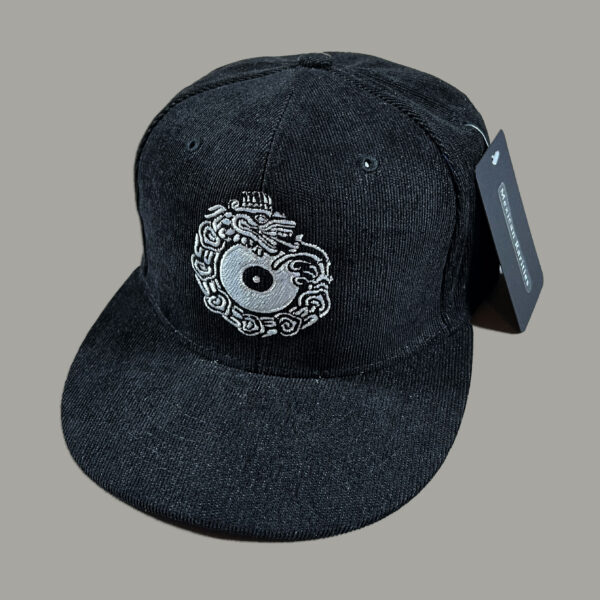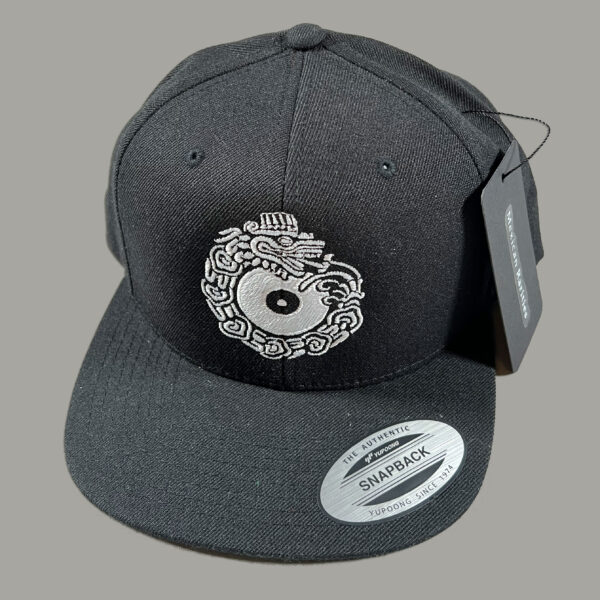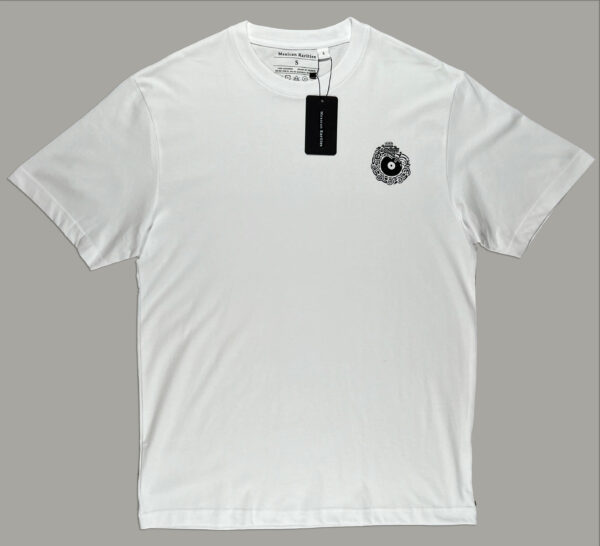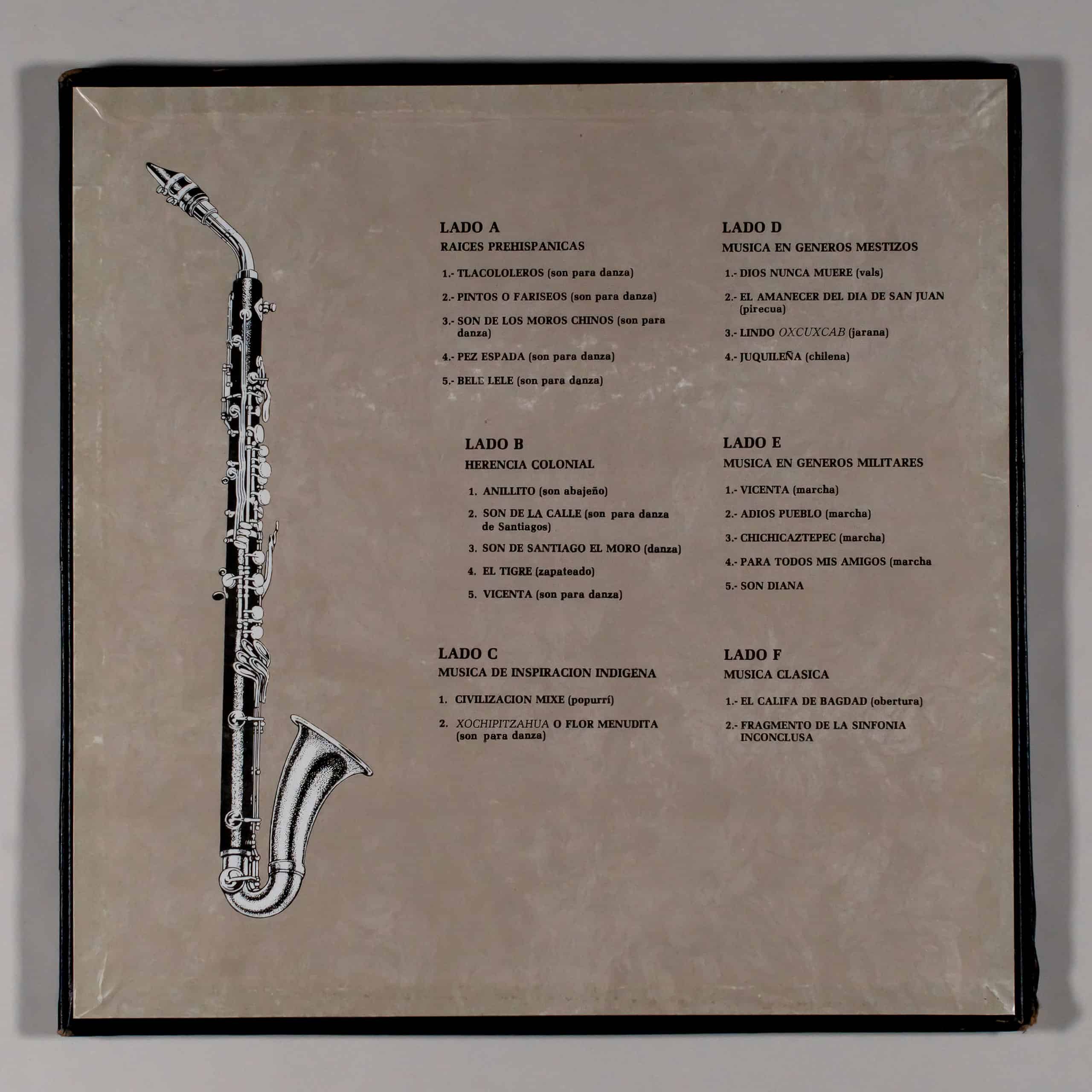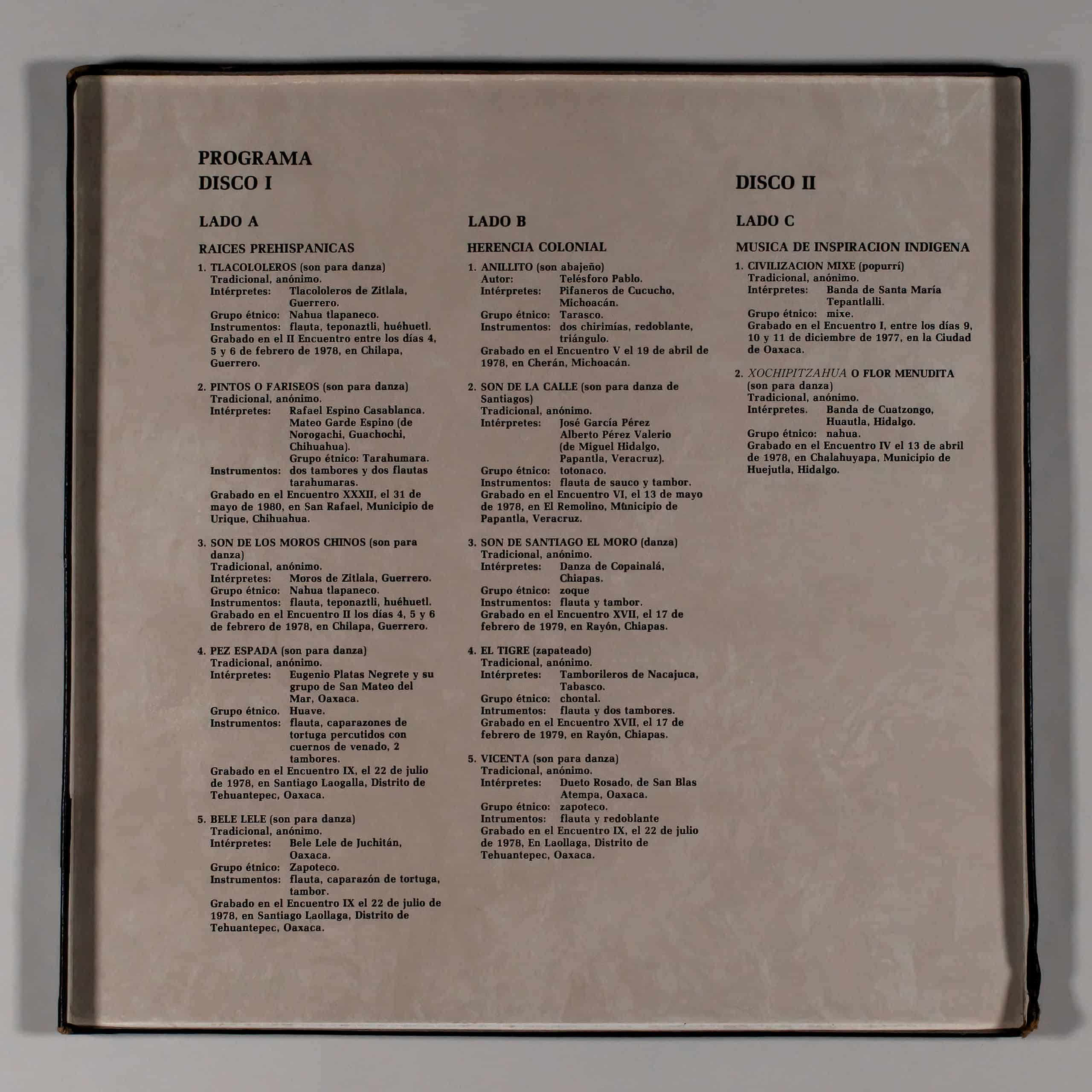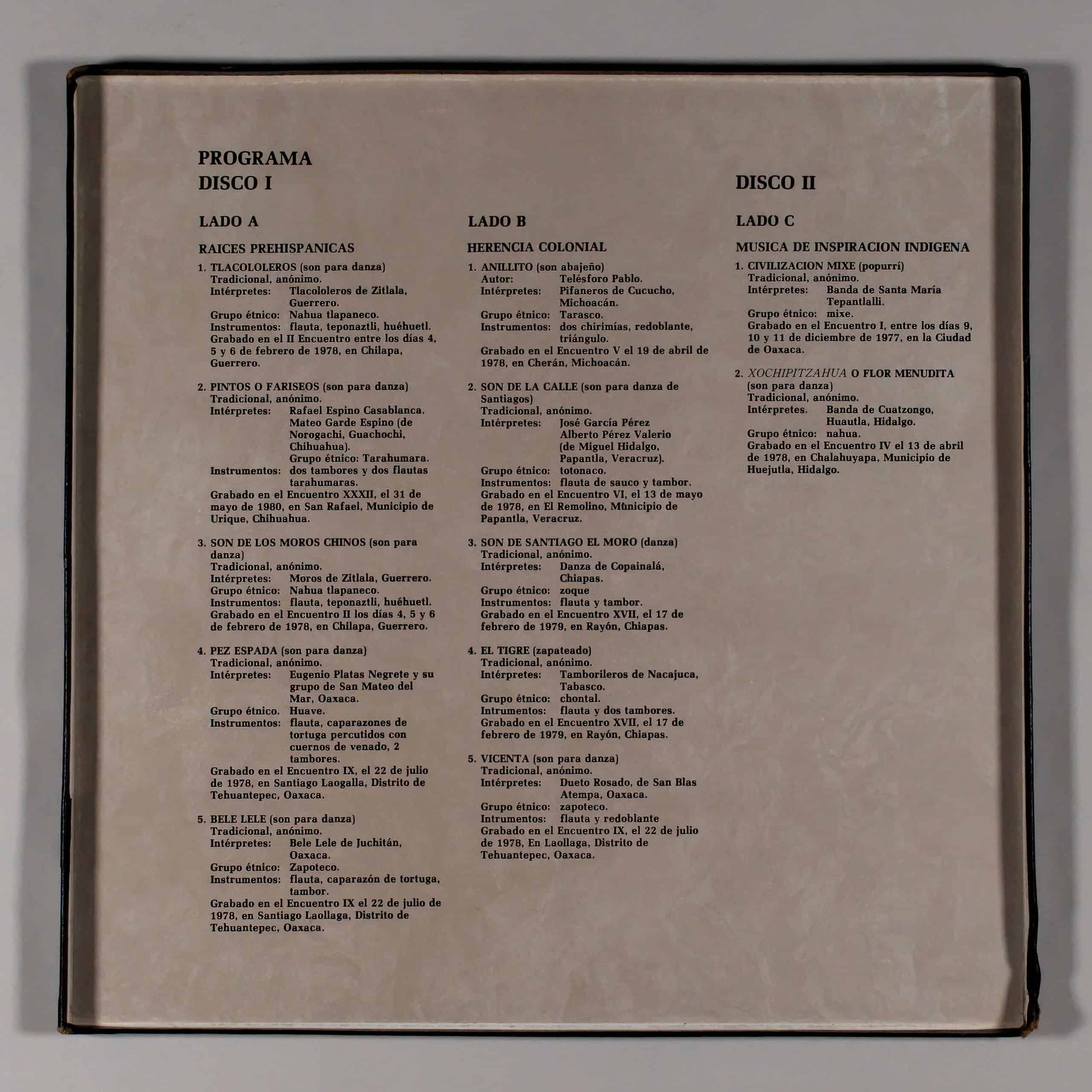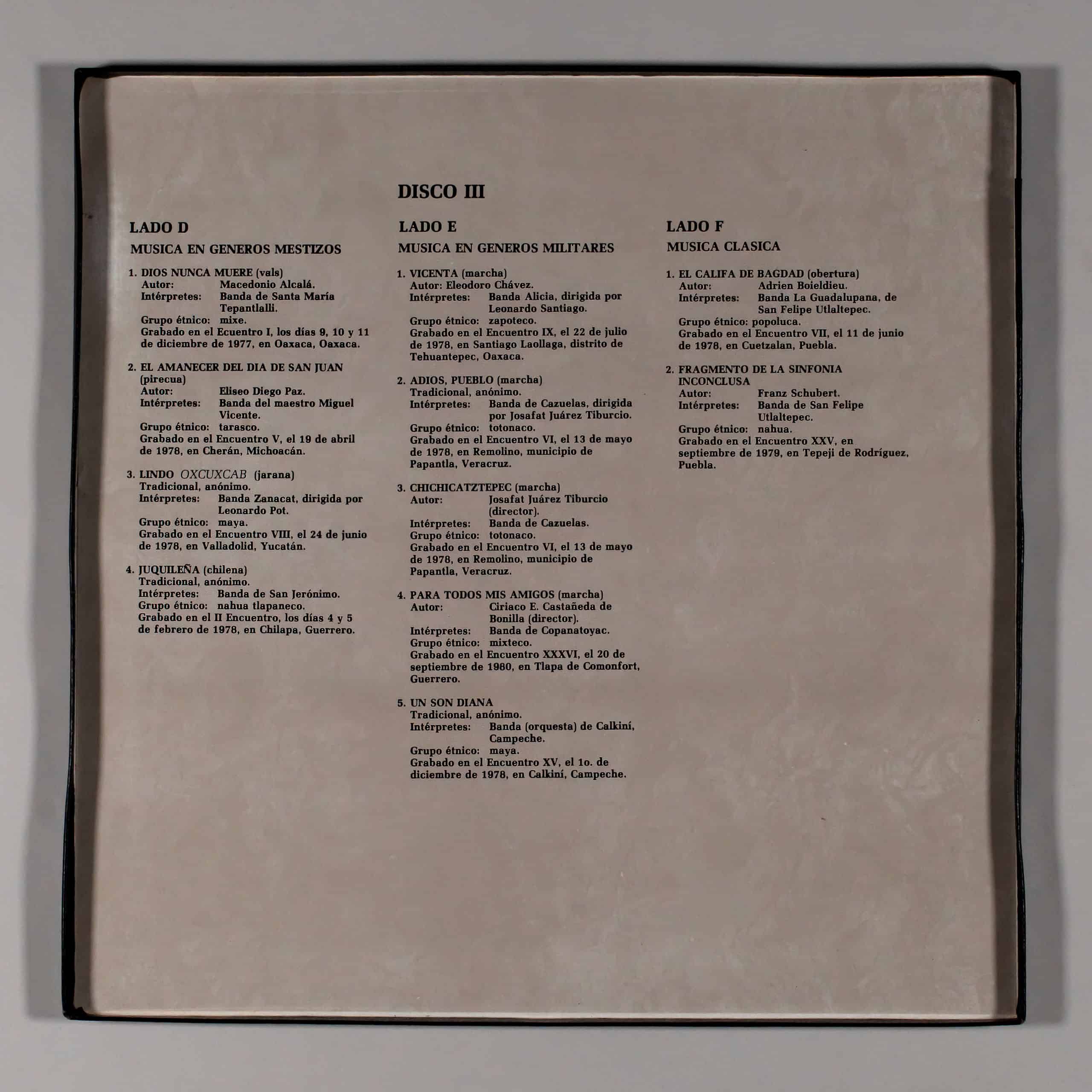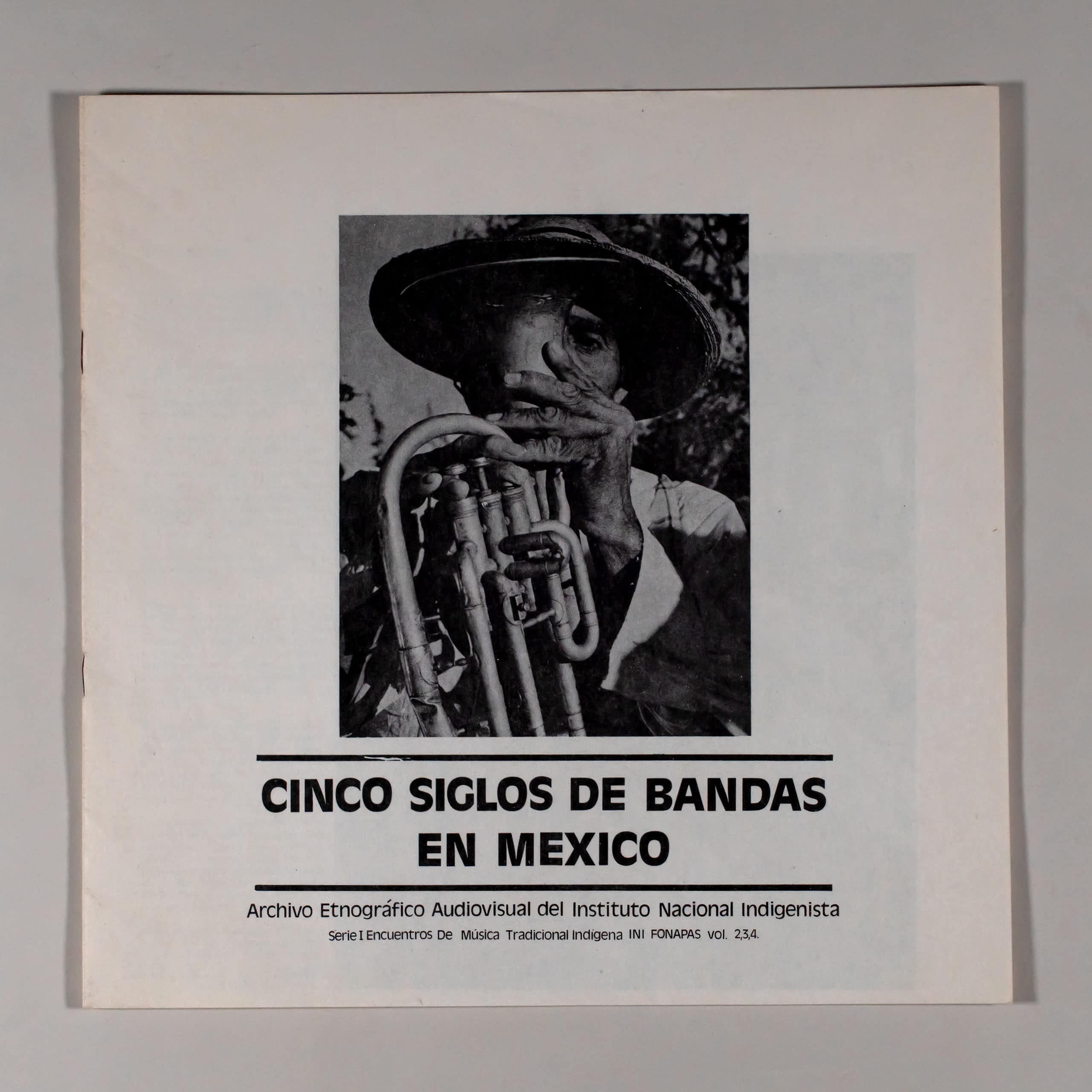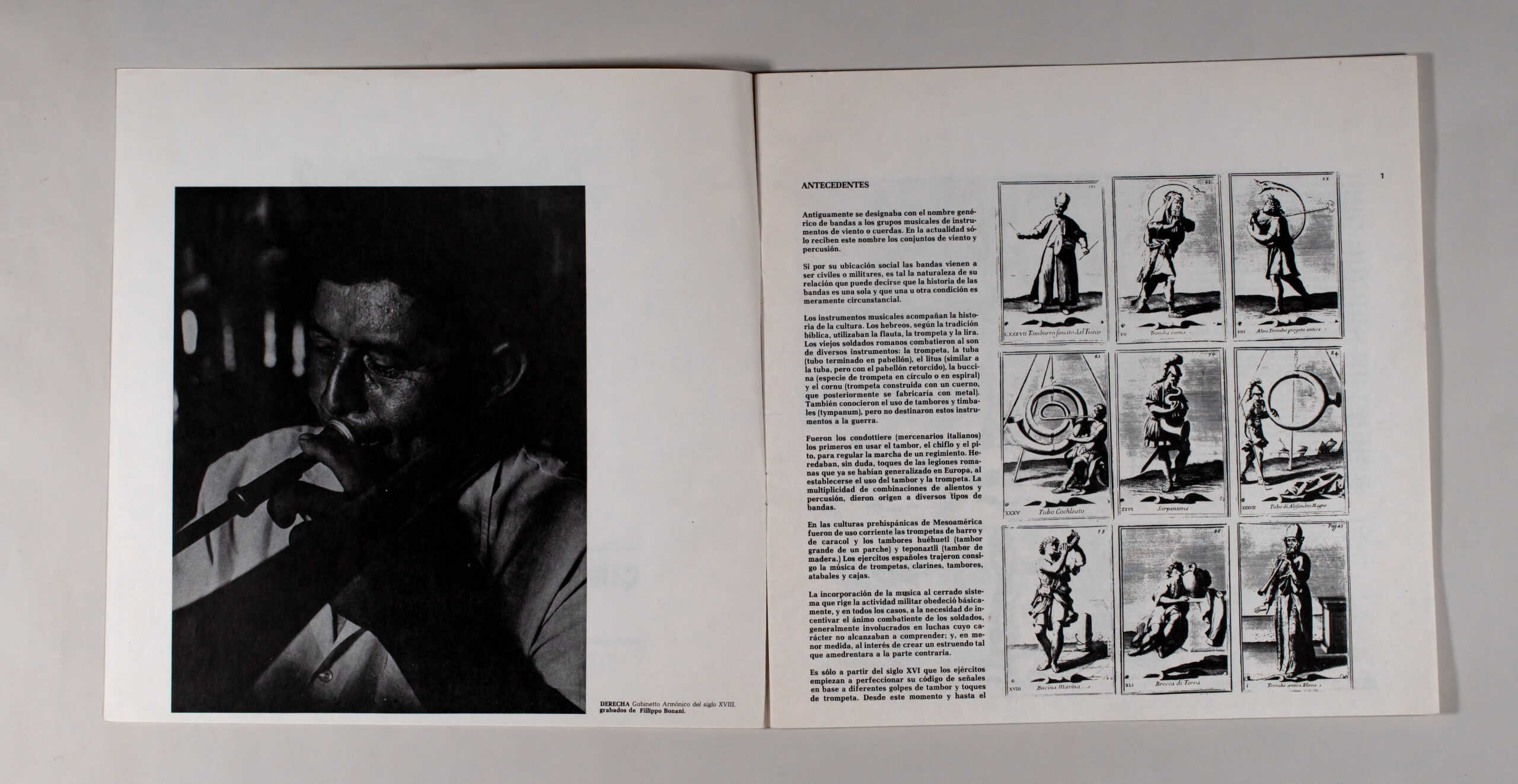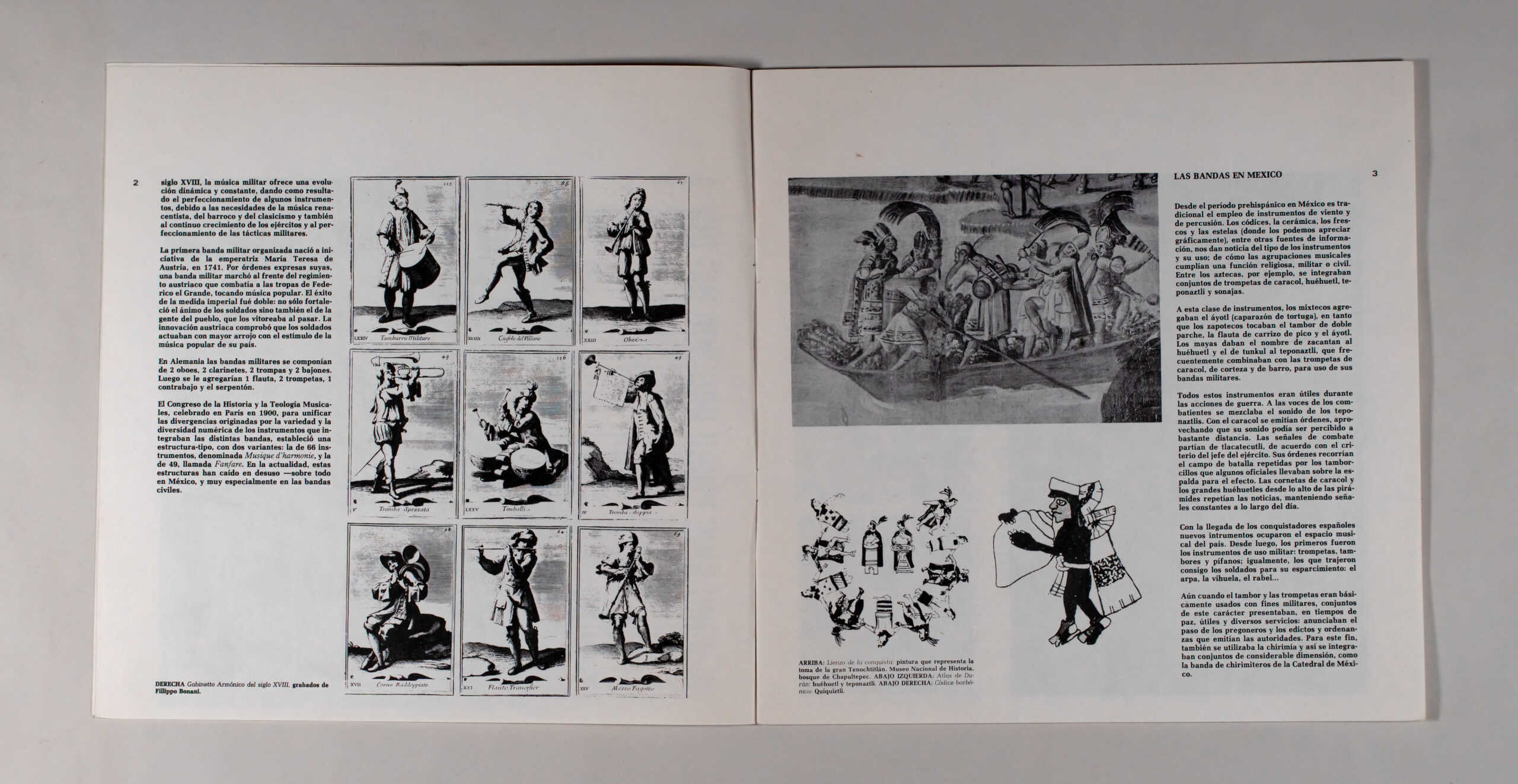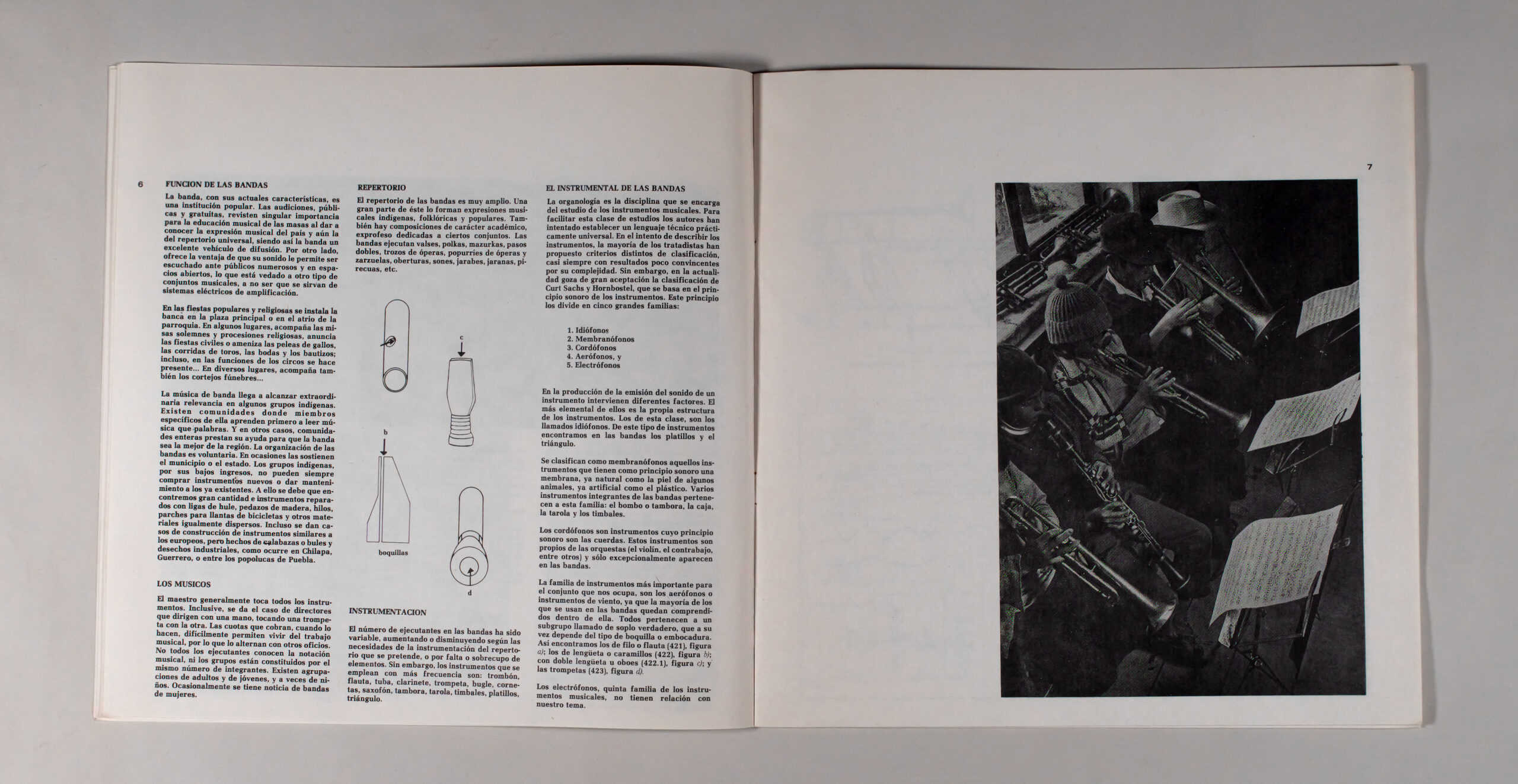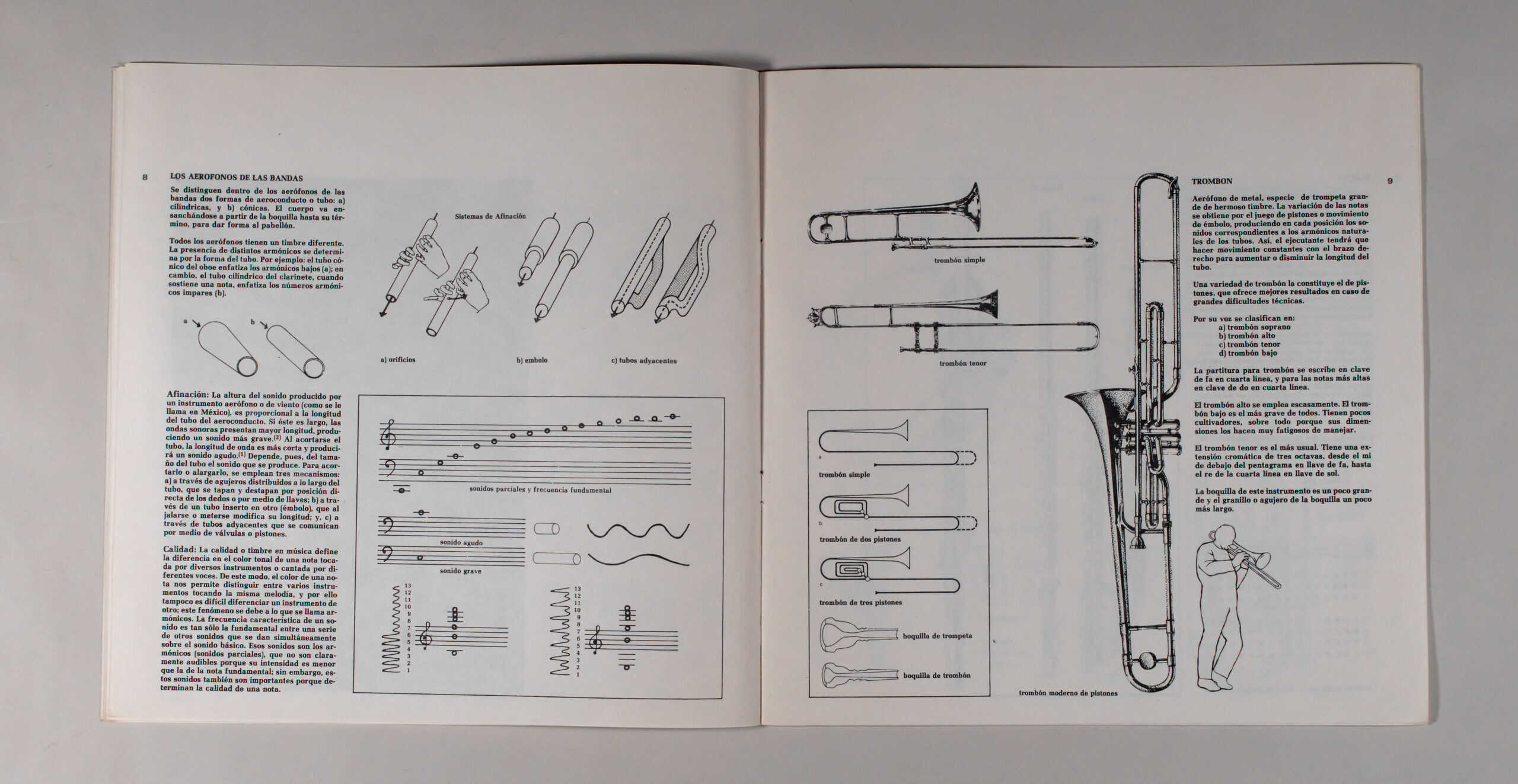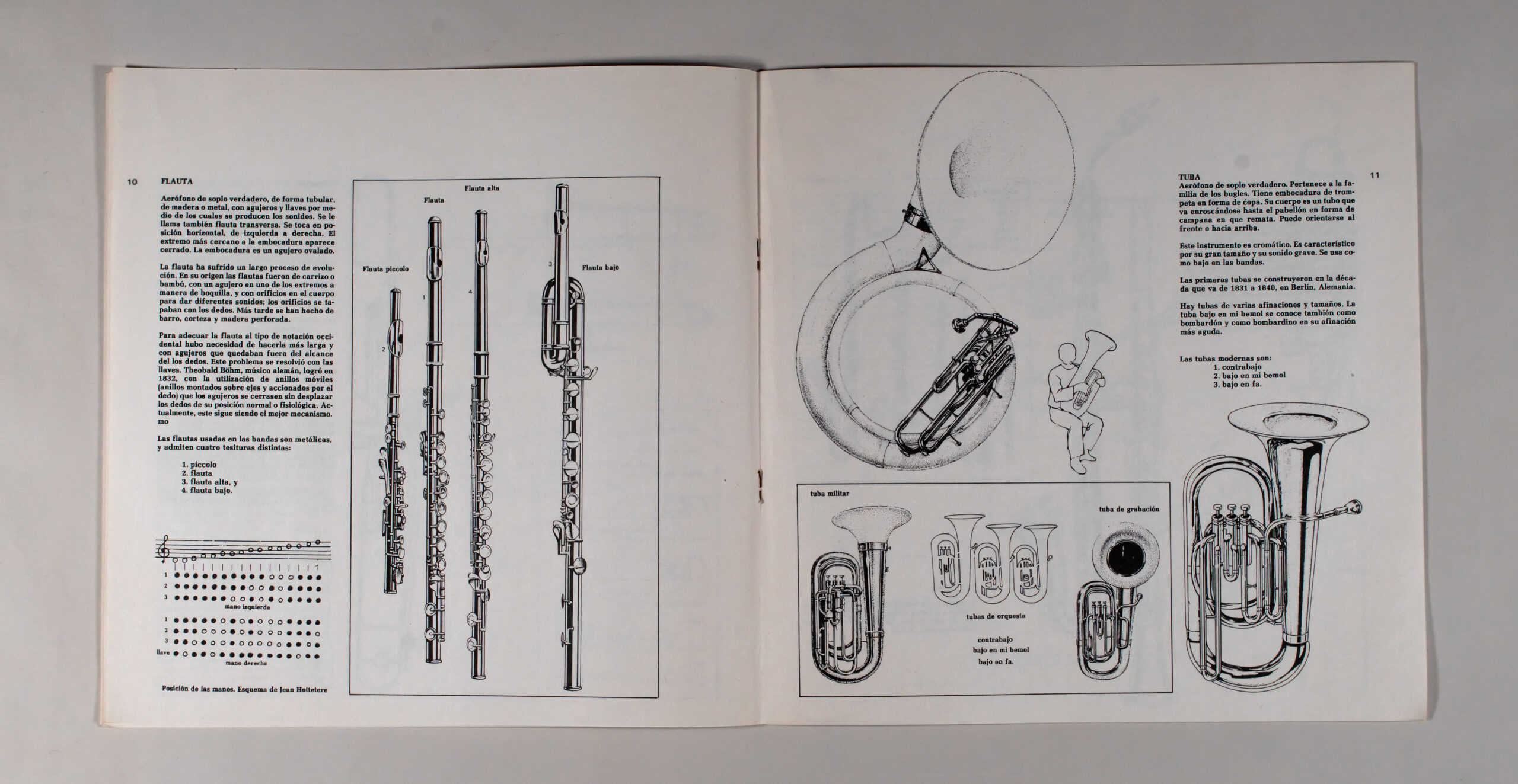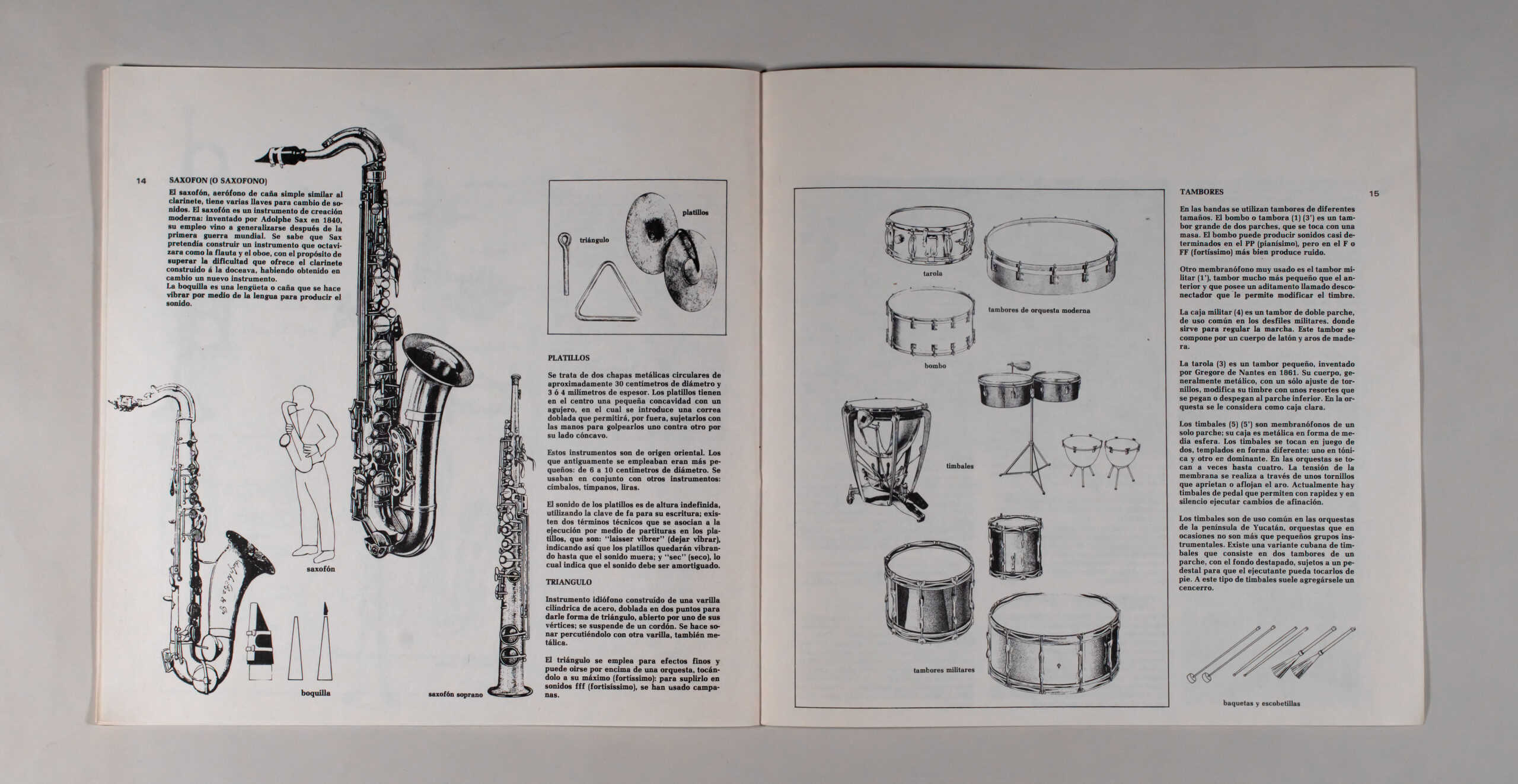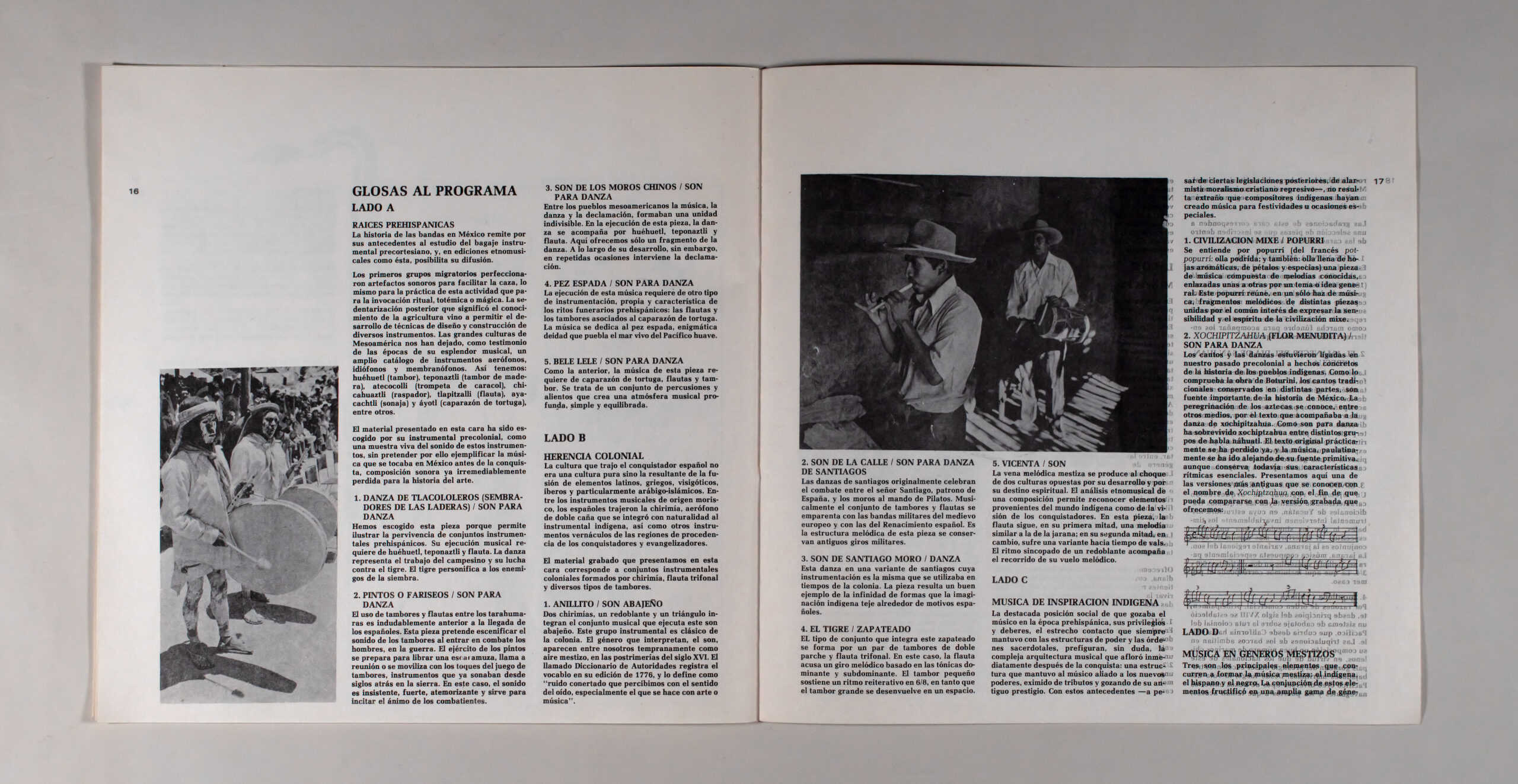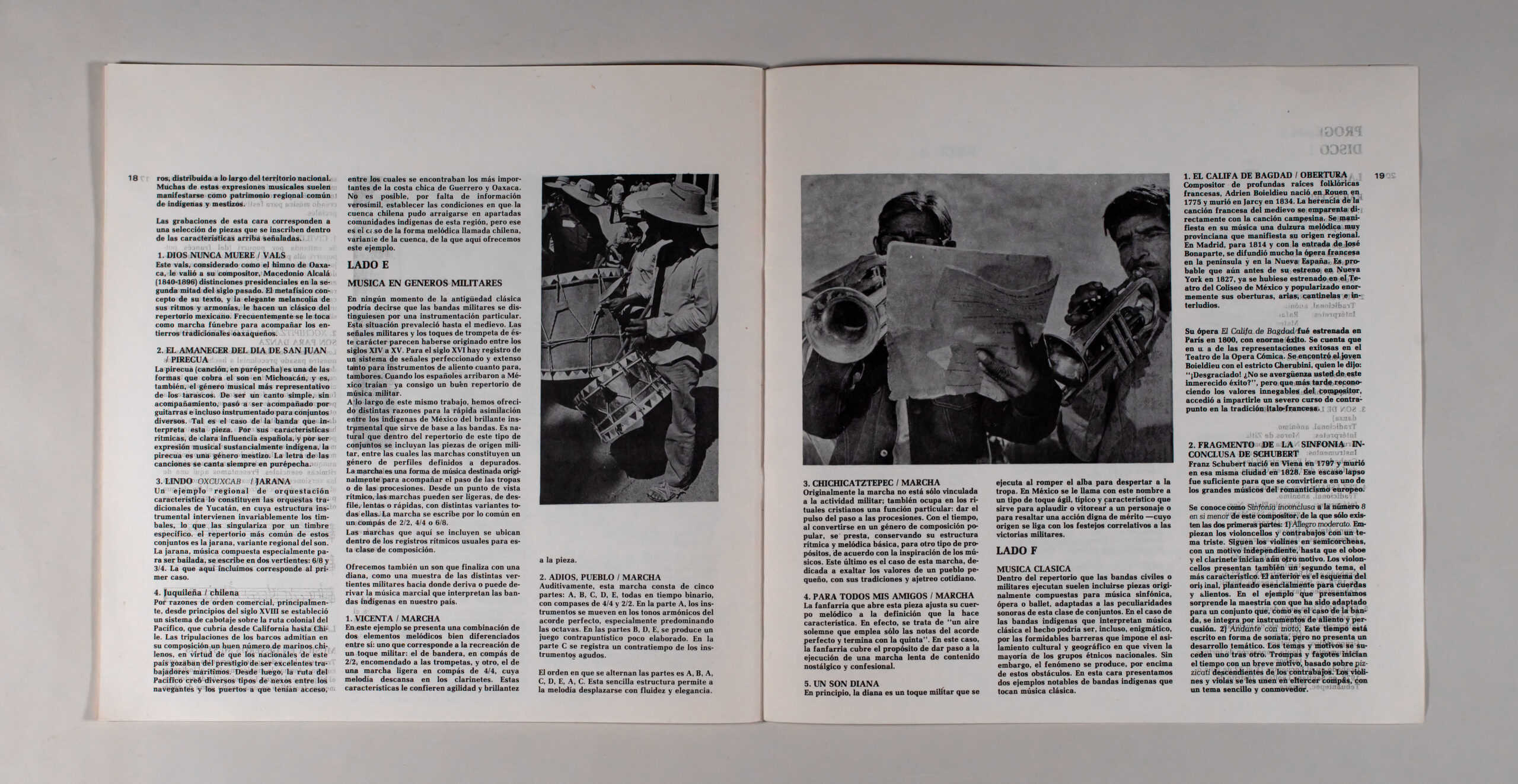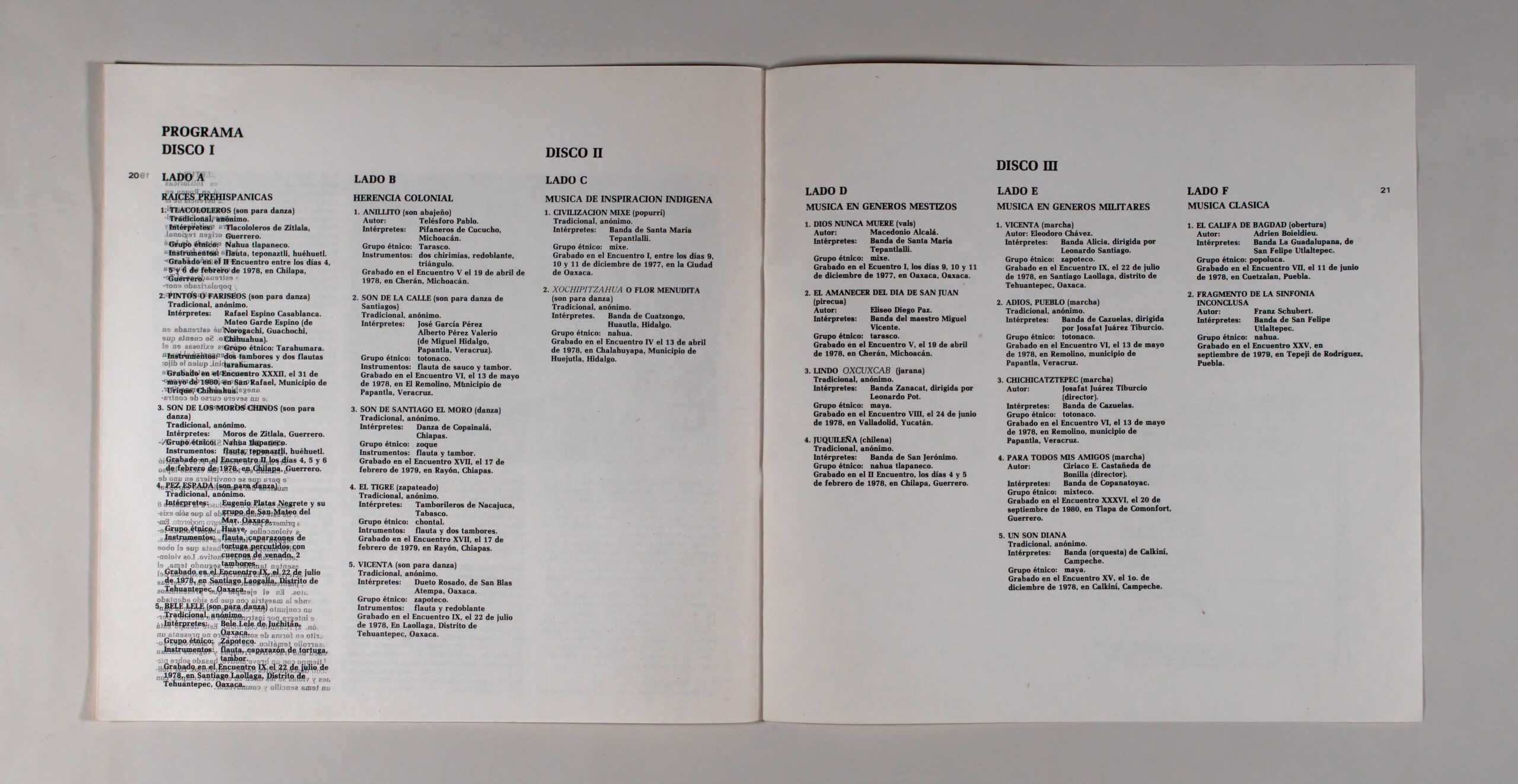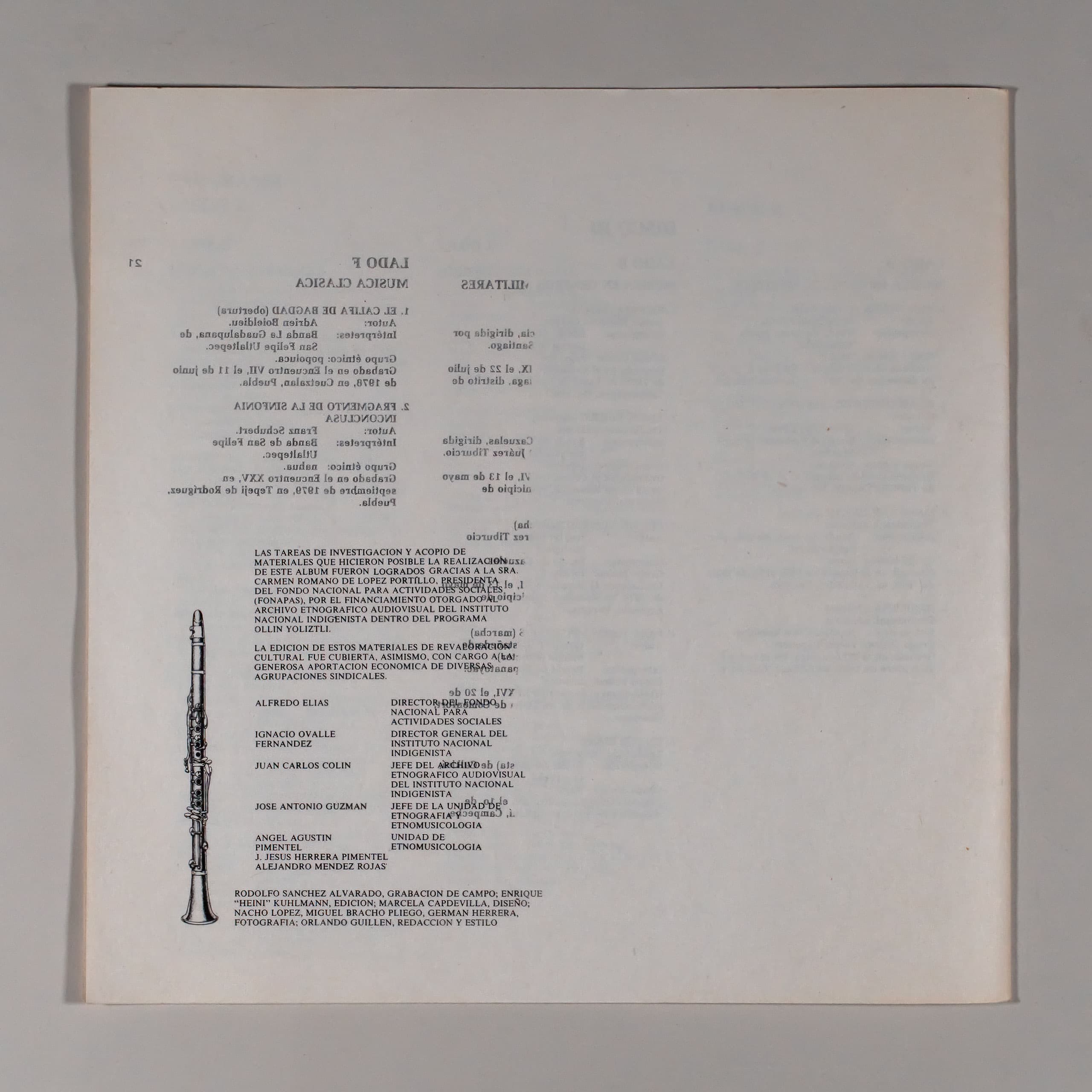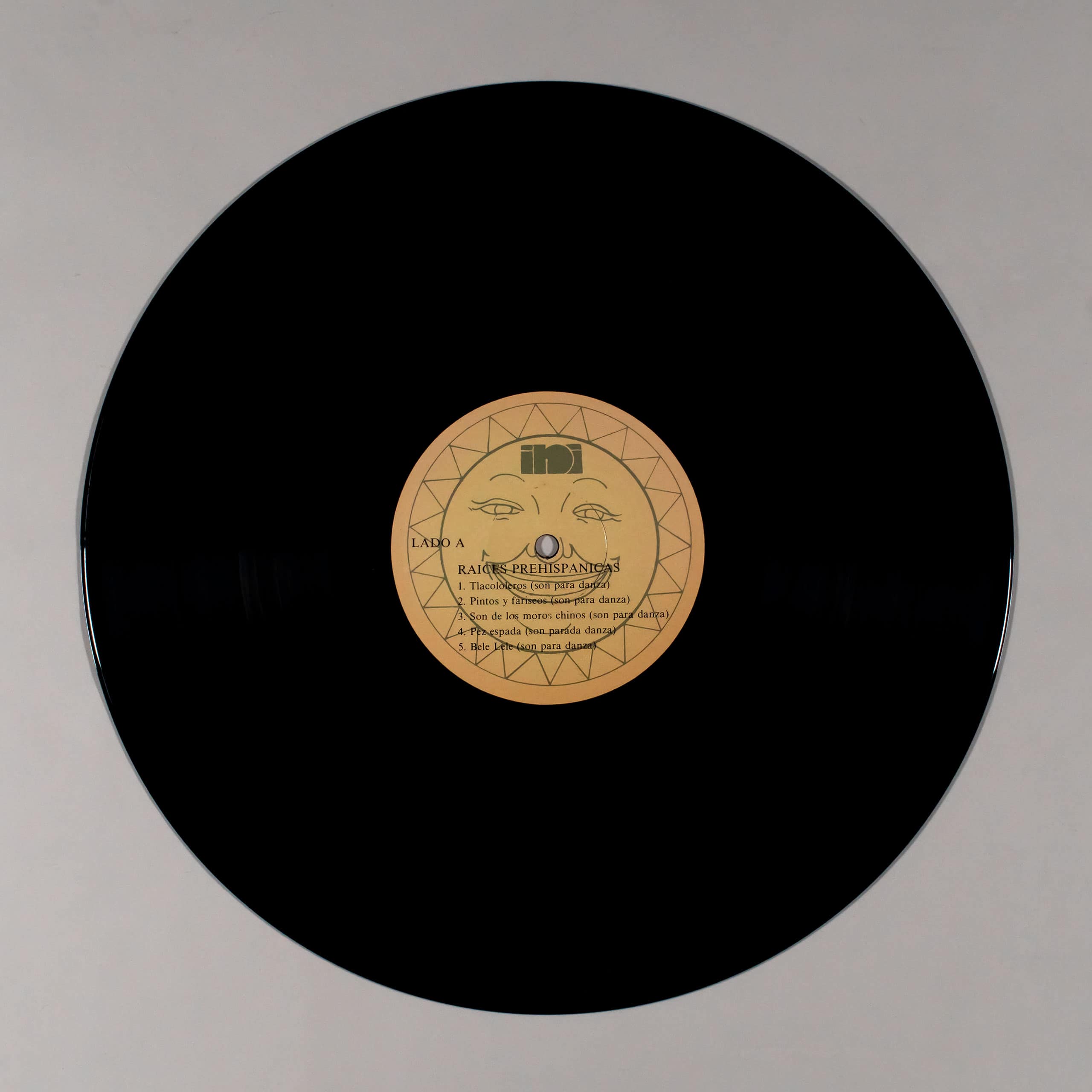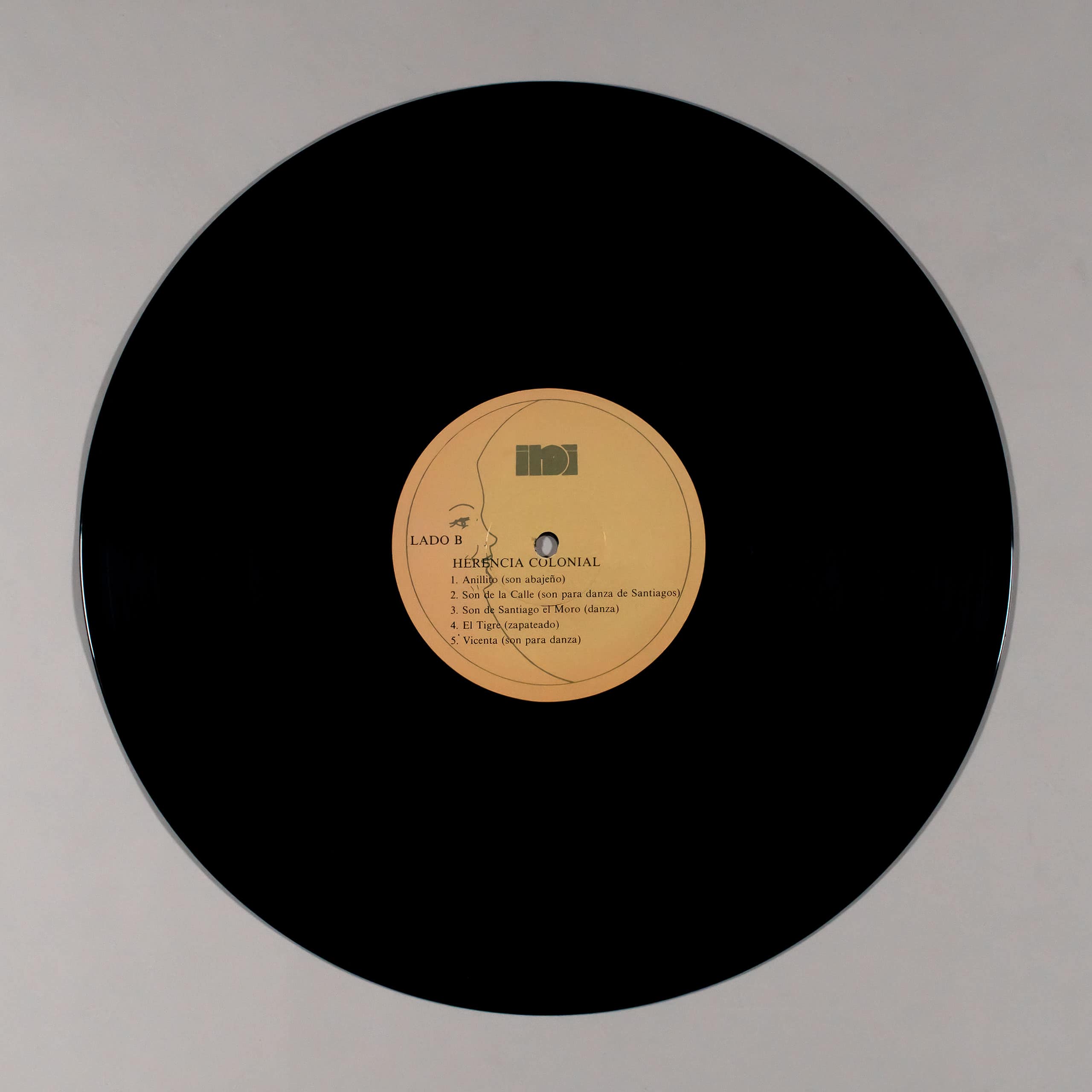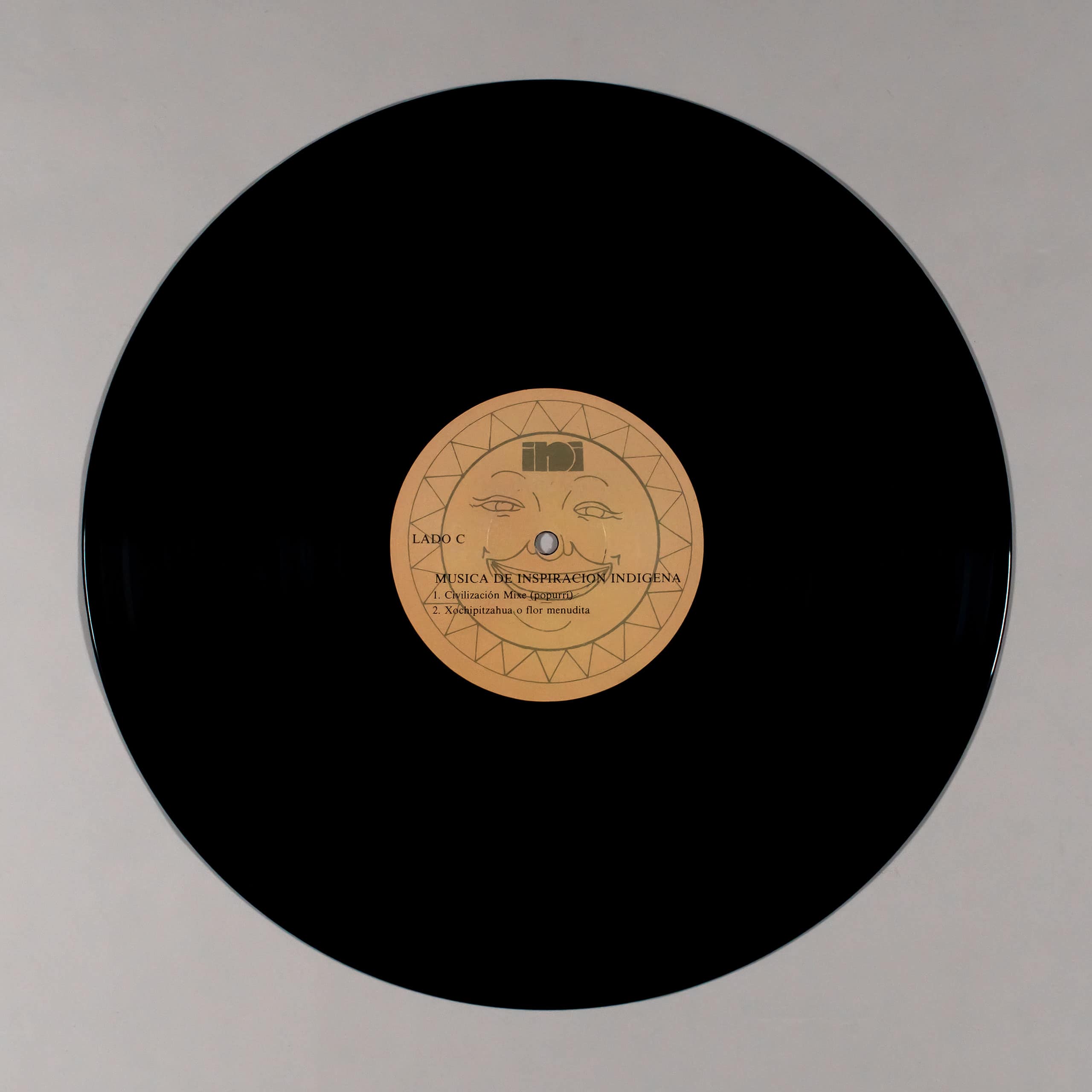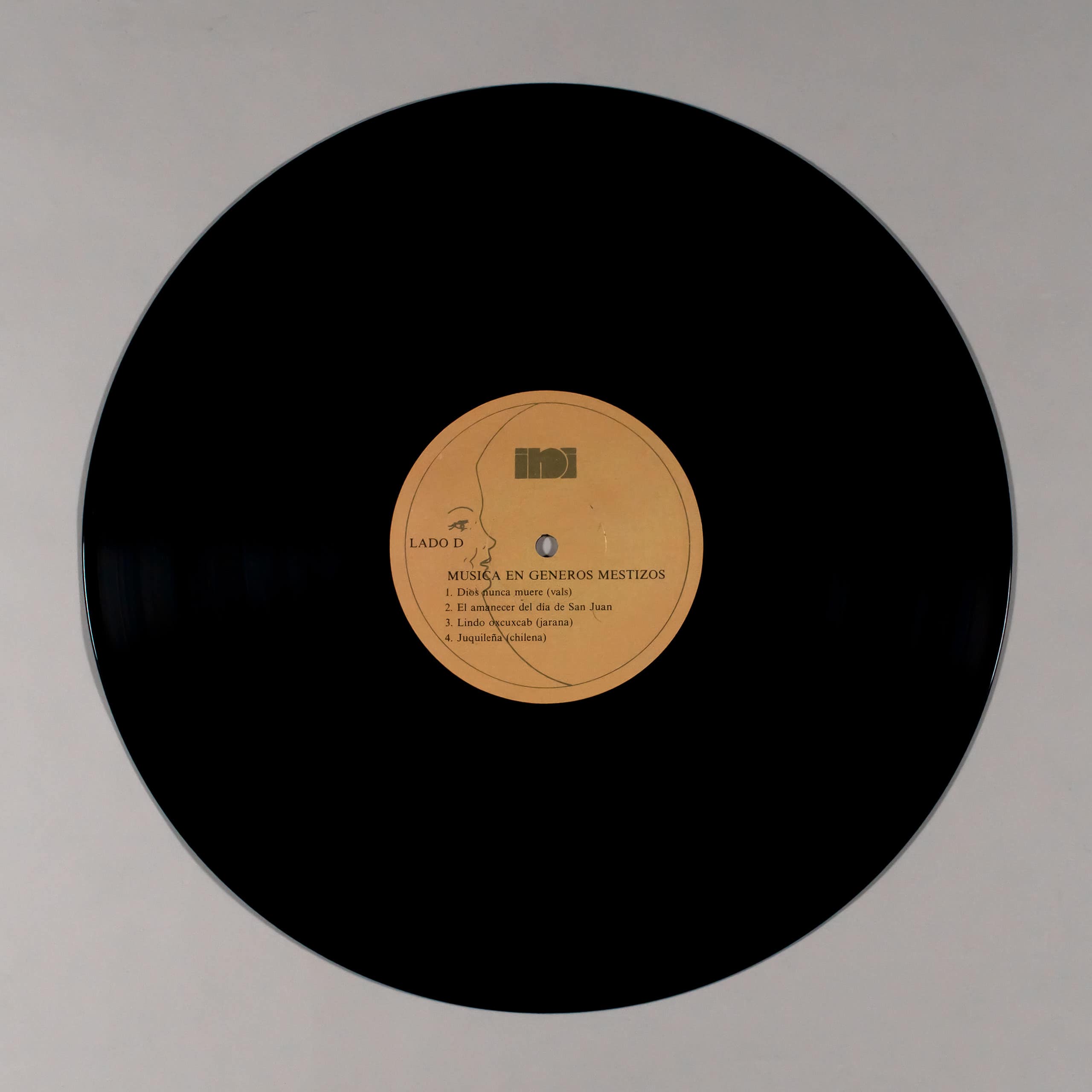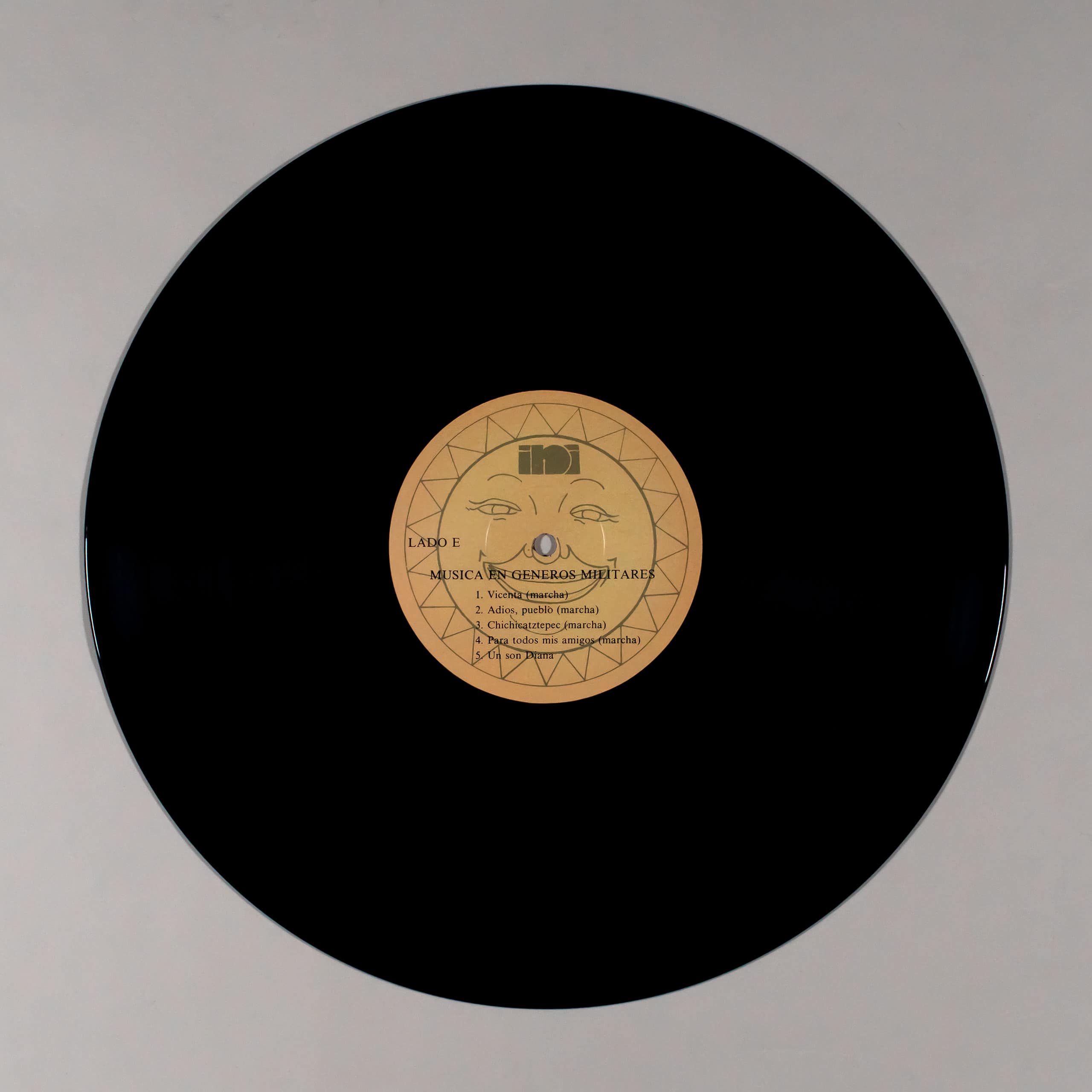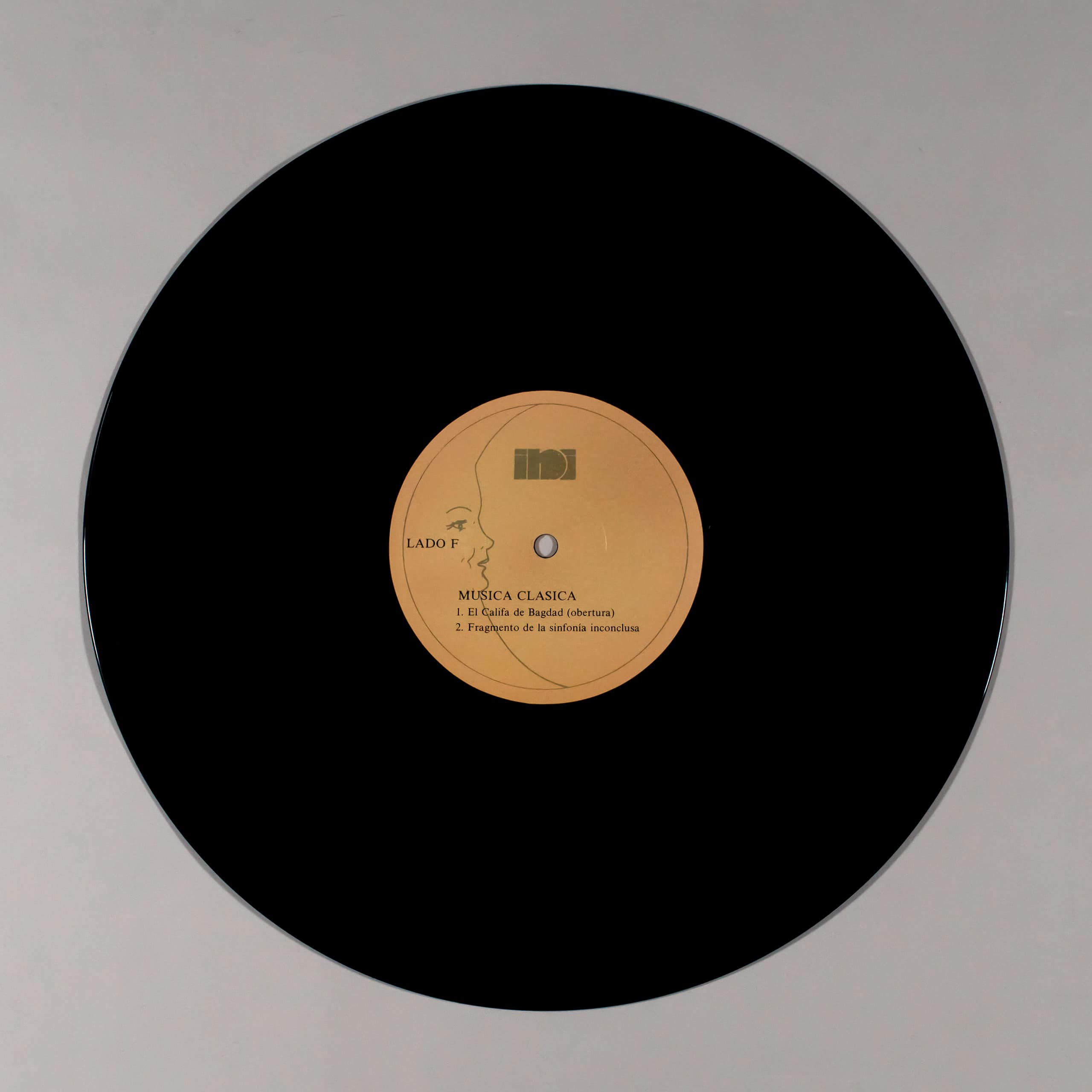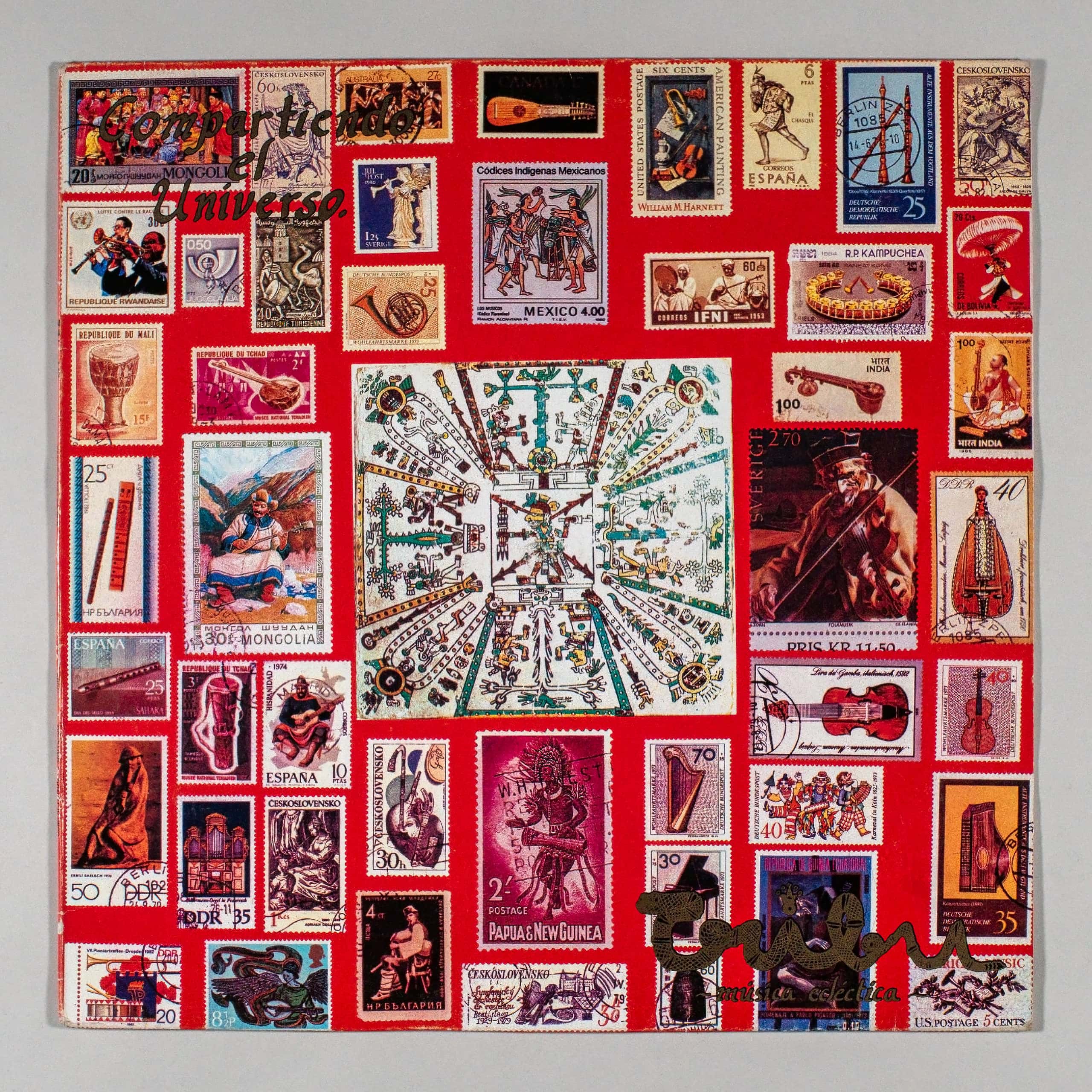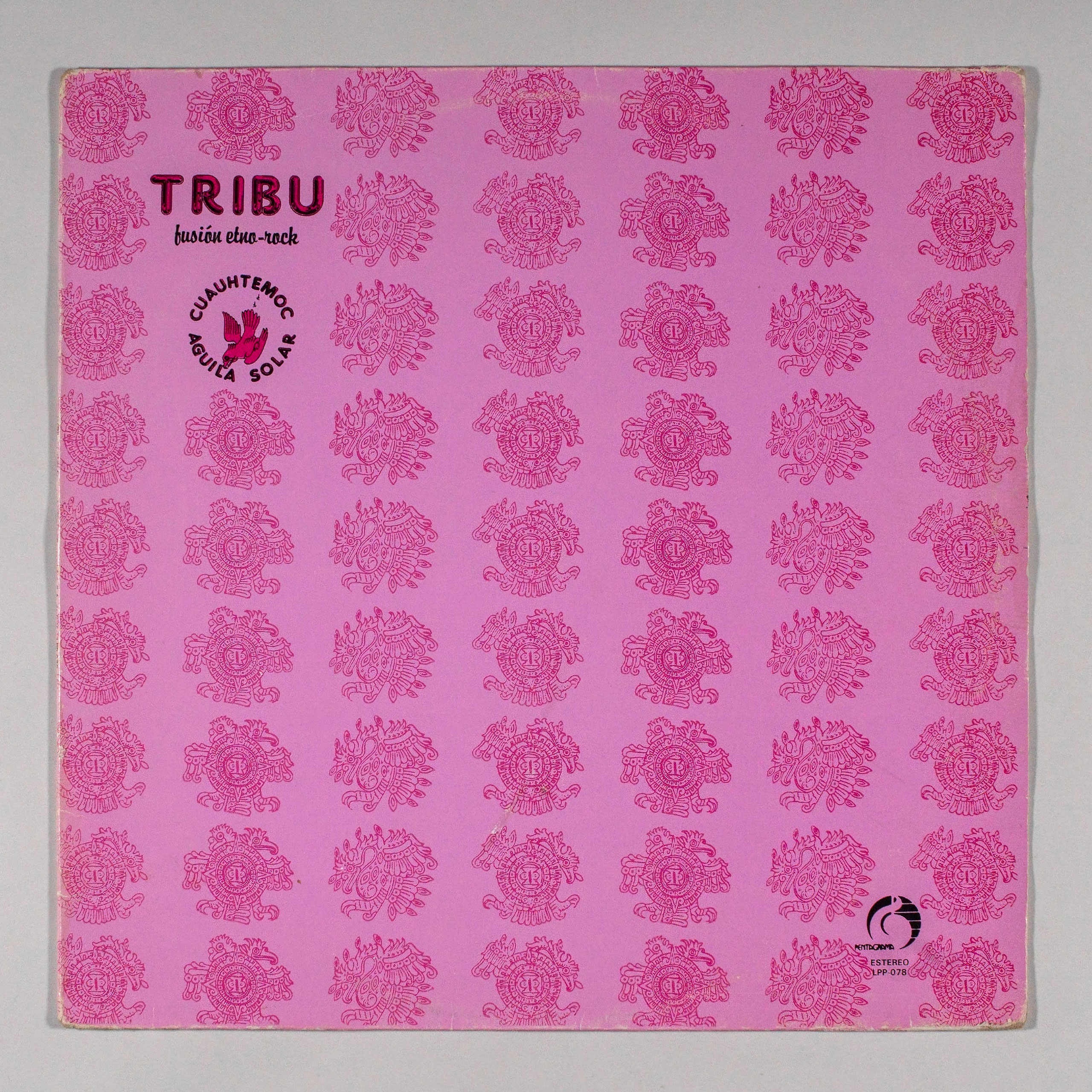FIVE CENTURIES OF BANDS IN MEXICO
Fonapas Ini
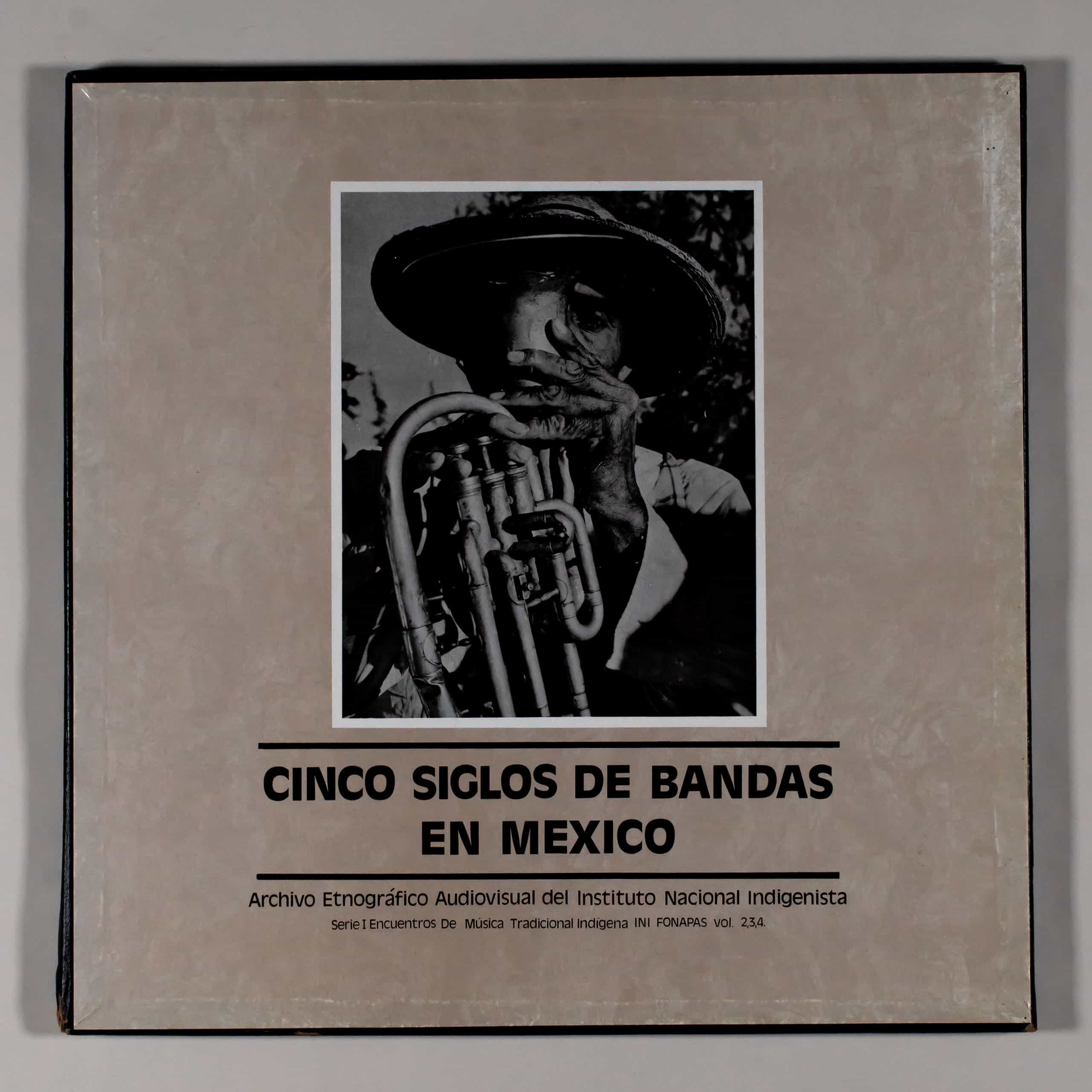
|
Label: FONAPAS-INI SERIES I, VOL. 2, 3, 4 Released: 1980 |
Country: Mexico Genre: Folk World & Country |
Info:
Five Centuries Of Bands In Mexico
Audiovisual Ethnographic Archive of the National Indigenous Institute
Series I Meetings of Traditional Indigenous Music INI FONAPAS Vol. 2,3,4.
BACKGROUND
Formerly, the generic name of bands was used to refer to musical groups of wind or string instruments. At present, only wind and percussion ensembles receive this name.
If, due to their social location, the gangs come to be civil or military, the nature of their relationship is such that it can be said that the history of the gangs is one and that one condition or the other is merely circumstantial.
Musical instruments accompany the history of culture. The Hebrews, according to the biblical tradition, used the flute, the trumpet and the lyre. The ancient Roman soldiers fought to the sound of various instruments: the trumpet, the tuba (tube ending in a bell), the litus (similar to the tuba, but with a twisted bell), the buccina (a kind of trumpet in a circle or spiral) and the cornu (trumpet built with a horn, which would later be made of metal). They also knew the use of drums and kettledrums (tympanum), but they did not use these instruments for war.
The condottiere (Italian mercenaries) were the first to use the drum, the chiflo and the whistle to regulate the march of a regiment. They inherited, without a doubt, touches from the Roman legions that had already become general in Europe, when the use of the drum and trumpet was established. The multiplicity of combinations of breath and percussion gave rise to various types of bands.
In the pre-Hispanic cultures of Mesoamerica, clay and shell trumpets and the huehuetl drums (large drum with a head) and teponaztli (wooden drum) were commonly used. The Spanish armies brought with them the music of trumpets, bugles, drums, coffins and boxes.
The incorporation of music into the closed system that governs military activity was basically due, and in all cases, to the need to encourage the fighting spirit of the soldiers, generally involved in fights whose nature they did not understand; and, to a lesser extent, in the interest of creating such a noise that it would intimidate the opposing party.
It is only from the 16th century that the armies begin to perfect their code of signals based on different drumbeats and trumpet blasts. From this moment until the 18th century, military music offers a dynamic and constant evolution, resulting in the improvement of some instruments, due to the needs of Renaissance, Baroque and Classic music, and also to the continuous growth of armies. and to the improvement of military tactics.
The first organized military band was born at the initiative of Empress Maria Theresa of Austria, in 1741. By her express orders, a military band marched at the head of the Austrian regiment that was fighting Frederick the Great’s troops, playing popular music. The success of the imperial measure was twofold: it not only strengthened the spirits of the soldiers but also that of the townspeople, who cheered as they passed. The Austrian innovation proved that the soldiers acted with greater courage with the encouragement of the popular music of their country.
In Germany the military bands were made up of 2 oboes, 2 clarinets, 2 horns and 2 bassoons. Then 1 flute, 2 trumpets, 1 double bass and the serpent would be added.
The Congress of Musical History and Theology, held in Paris in 1900, to unify the divergences caused by the variety and numerical diversity of the instruments that make up the different bands, established a typical structure, with two variants: the 66 instruments, called Musique d’harmonie, and that of 49, called Fanfare. At present, these structures have fallen into disuse –especially in Mexico, and especially in civilian gangs–.
THE BANDS IN MEXICO
Since the pre-Hispanic period in Mexico, the use of wind and percussion instruments has been traditional. The codices, ceramics, frescoes and stelae (where we can appreciate them graphically), among other sources of information, give us information on the type of instruments and their use; of how musical groups fulfilled a religious, military or civil function. Among the Aztecs, for example, sets of conch trumpets, huehuetl, teponaztli and rattles were integrated.
To this class of instruments, the Mixtecs added the ayotl (turtle shell), while the Zapotecs played the double-headed drum, the reed-beaked flute, and the áyotl. The Maya gave the name zacantan to the huehuetl and tunkul to the teponaztli, which they frequently combined with snail, bark and mud trumpets, for the use of their military bands.
All these instruments were useful during war actions. The voices of the combatants were mixed with the sound of the teponaztlis. Orders were issued with the snail, taking advantage of the fact that its sound could be perceived at a great distance. The combat signals started from tlacatecutli, according to the criteria of the head of the army. His orders went around the battlefield repeated by the drums that some officers carried on their backs for this purpose. The snail bugles and the great huehuetles from the top of the pyramids repeated the news, maintaining constant signals throughout the day.
With the arrival of the Spanish conquerors, new instruments occupied the musical space. from the country. Of course, the first were the instruments for military use: trumpets, drums and fifes; likewise, those that the soldiers brought with them for their recreation: the harp, the vihuela, the rebec…
Even though the drum and trumpets were basically used for military purposes, groups of this nature presented, in times of peace, tools and various services: they announced the passage of town criers and the edicts and ordinances issued by the authorities. For this purpose, the shawm was also used and thus groups of considerable size were integrated, such as the band of chirimiteros of the Cathedral of Mexico.
The musicians and their instruments preceded the passing of the banner at festivals and processions, contributing with their imposing presence to the color and splendor of this type of event. Receptions of viceroys, victories of Spain, deaths of kings or canonizations were especially celebrated in the Colony with groups of indigenous and Spanish bands in large processional mitotes.
Spanish clergymen had a decisive influence on the dissemination and knowledge of instruments and musical genres of European origin. Fray Pedro de Gante began teaching instrument making in Texcoco with a hard-working and attentive indigenous group. Torquemada, who collects these testimonies, says that the first instruments built there were flutes, shawms, orlos, vihuelas de arco, cornets and bassones. In this way, the use of the new instruments became accessible to the natives, since it was no longer necessary to import them from the Spanish metropolis, an operation that, due to its price, was not within the reach of most musicians.
The singers and instrumentalists were distributed and assigned to the service of the churches. Starting in 1547, the Cathedral of Mexico City admitted lay musicians capable of various instruments to integrate its orchestra, with the purpose of using it in religious and festive services. The use of an instrument became widespread, the sackbut, which was part of that orchestra and can be considered as an antecedent of the current trombones.
The most common breath instruments of the colonial era were the trumpet and the bugle, especially in matters of a military order. The sackbut (introduced, as we have seen, in the 16th century), the oboe and the bassoon, became popular in the 18th century, especially for compositions of a religious nature. Until the middle of the last century, the church had the best musicians, both composers and instrumentalists.
The first military bands of independent Mexico were officially established in 1867, after the triumph of the Republic. It was a question of equipping each battalion with a military music band, possibly inspired by the excellent bands of the expeditionary army of Marshal Bazaine or the imperial guard of Maximilian of Austria. The Mexican military bands were formed with national musicians selected from among the numerous instrument players in the country. Musicians from all states were recruited to fill their positions, thus forming bands of very high musical quality. The formation of the military bands caused the disintegration of the then existing civil bands. Only in the capital were they organized with the distribution of one for each barracks in the city.
When the civil gangs reappeared in the towns (including those bordering the urban centers), the same did not happen in the cities.
Bands became part of our musical institutions at the beginning of this century (1910), when the instrumentation class for military bands was created at the Conservatory. This is how Julián Carrillo recalls it in his work Universal errors in music and musical physics, in the chapter on instrumentation for a military band.
Porfirio Díaz was concerned with providing his native state, Oaxaca, with the best bands of that time, entrusting Macedonio Alcalá, author of the waltz Dios Nunca Muere (side D), with the Conservatory and public musical instruction. The rise of indigenous bands in Oaxaca, Morelos and Michoacán dates from the beginning of this century.
In 1920, the Secretary of War and the Navy, Plutarco Elías Calles, created the Inspection of Military Musicians, headed by Major Atanasio Castañeda. However, a short time later, a new Secretary of War and Navy, Joaquín Amaro, disappeared the unit for reasons of an economic nature. That was how the members of the gangs that the defunct office supported began to reinforce the civilian gangs.
On the other hand, the gangs have gained more and more roots in the different ethnic groups of the country that generally live in remote regions, devoid of electricity services, among other things. Under these conditions, the bands become factors of recreation, coexistence and social and religious cohesion.
FUNCTION OF THE BANDS
The band, with its current characteristics, is a popular institution. The auditions, public and free, are of singular importance for the musical education of the masses by making known the musical expression of the country and even that of the universal repertoire, thus making the band an excellent vehicle for dissemination. On the other hand, it offers the advantage that its sound allows it to be heard before large audiences and in open spaces, which is forbidden to other types of musical ensembles, unless they use electrical amplification systems.
In popular and religious festivals, the bench is installed in the main square or in the atrium of the parish. In some places, it accompanies solemn masses and religious processions, announces civil festivities or enlivens cockfights, bullfights, weddings and baptisms; it is even present in circus performances… In various places, it also accompanies funeral processions…
Banda music reaches extraordinary relevance in some indigenous groups. There are communities where specific members of it first learn to read music than words. And in other cases, entire communities lend their help to make the band the best in the region. The organization of the bands is voluntary. Sometimes they are supported by the municipality or the state. The indigenous groups, due to their low income, cannot always buy new instruments or maintain existing ones. This is why we find a large number of instruments repaired with rubber bands, pieces of wood, threads, patches for bicycle tires and other similarly scattered materials. There are even cases of construction of instruments similar to the European ones, but made of gourds or bules and industrial waste, as occurs in Chilapa, Guerrero, or among the Popolucas of Puebla.
THE MUSICIANS
The teacher usually plays all the instruments. There is even the case of directors who direct with one hand, playing a trumpet with the other. The fees they charge, when they do, hardly allow them to make a living from musical work, so they alternate it with other trades. Not all the performers know the musical notation, nor are the groups made up of the same number of members. There are groups of adults, youth, and sometimes children. Occasionally there is news of gangs of women.
REPERTOIRE
The repertoire of the bands is very wide. A large part of this is made up of indigenous, folkloric and popular musical expressions. There are also compositions of an academic nature, expressly dedicated to certain ensembles. The bands play waltzes, polkas, mazurkas, pasodobles, excerpts from operas, medleys of operas and zarzuelas, overtures, sones, jarabes, jaranas, pirekuas, etc.
INSTRUMENTATION
The number of performers in the bands has been variable, increasing or decreasing according to the needs of the instrumentation of the intended repertoire, or due to a lack or overcrowding of elements. However, the instruments that are most frequently used are: trombone, flute, tuba, clarinet, trumpet, bugle, bugles, saxophone, tambora, snare drum, timpani, cymbals, triangle.
THE INSTRUMENTAL OF THE BANDS
Organology is the discipline that deals with the study of musical instruments. To facilitate this kind of study the authors have tried to establish a practically universal technical language. In the attempt to describe the instruments, most writers have proposed different classification criteria, almost always with unconvincing results due to their complexity. However, the classification of Curt Sachs and Hornbostel, which is based on the sound principle of instruments, is currently widely accepted. This principle divides them into five large families:
- Idiophones
- Membranophones
- Chordophones
- Aerophones, and
- Electronics
In the production of the sound emission of a more elementary of them is the instrument structure itself, different factors intervene. The one with the instruments. Those of this class are called idiophones. Of this type of instruments we find in the bands the cymbals and the triangle.
Instruments whose sound principle is a membrane, either natural like the skin of some animals, or artificial like plastic, are classified as membranophones. Several instruments belonging to the bands belong to this family: the bass drum or tambora, the box, the tarola and the timpani.
The chordophones are instruments whose sound principle is the strings. These instruments are typical of orchestras (violin, double bass, among others) and only exceptionally appear in bands.
The most important family of instruments for the group in question are the aerophones or wind instruments, since most of those used in the bands are included within it. They all belong to a subgroup called true breath, which in turn depends on the type of mouthpiece or mouthpiece. Thus we find those of edge or flute (421), figure a); those with reeds or pipes (422), figure b); with double reeds or oboes (422.1), figure c); and the trumpets (423), figure d).
Electrophones, the fifth family of musical instruments, have no relation to our topic.
THE AEROPHONES OF THE BANDS
Two forms of aero duct or tube are distinguished within the aerophones of the bands: a) cylindrical, and b) conical. The body widens from the mouthpiece to its end, to give shape to the pavilion.
All aerophones have a different timbre. The presence of different harmonics is determined by the shape of the tube. For example: the conical tube of the oboe emphasizes the low harmonics (a); instead, the cylindrical tube of the clarinet, when holding a note, emphasizes the odd harmonic numbers (b).
Tuning: The height of the sound produced by an aerophone or wind instrument (as it is called in Mexico), is proportional to the length of the air duct tube. If it is long, the sound waves have a greater length, producing a lower sound.(2) As the tube is shortened, the wavelength is shorter and will produce a sharp sound.(1) It depends, then, on the size of the tube the sound that is produced. To shorten or lengthen it, three mechanisms are used: a) through holes distributed along the length of the tube, which are covered and uncovered by direct position of the fingers or by means of keys; b) through a tube inserted into another (plunger), which when pulled or inserted modifies its length; and, c) through adjacent tubes that communicate by means of valves or pistons.
Quality: The quality or timbre in music defines the difference in the tonal color of a note played by different instruments or sung by different voices. In this way, the color of a note allows us to distinguish between several instruments playing the same melody, and for this reason it is not difficult to differentiate one instrument from another; This phenomenon is due to what is called harmonics. The characteristic frequency of a sound is only the fundamental among a series of other sounds that occur simultaneously on the basic sound. Those sounds are the harmonics (partial sounds), which are not clearly audible because their intensity is less than that of the fundamental note; however, these sounds are also important because they determine the quality of a note.
TROMBONE
Metal aerophone, a kind of large trumpet with a beautiful timbre. The variation of the notes is obtained by the play of pistons or piston movement, producing in each position the sounds corresponding to the natural harmonics of the tubes. Thus, the performer will have to make constant movements with the right arm to increase or decrease the length of the tube.
A variety of trombone is the piston, which offers better results in case of great technical difficulties.
By their voice they are classified as:
a) soprano trombone
b) alto trombone
c) tenor trombone
d) bass trombone
The trombone score is written in the clef of bass on the fourth line, and for the higher notes in the clef of C on the fourth line.
The alto trombone is rarely used. The bass trombone is the lowest of all. They have few cultivators, especially since their dimensions make them very tiring to handle.
The tenor trombone is the most common. It has a chromatic extension of three octaves, from the E below the staff in the key of F, to the D of the fourth line in the key of G.
The mouthpiece of this instrument is a bit large and the grain or hole of the mouthpiece a little longer.
FLUTE
True breath aerophone, tubular in shape, made of wood or metal, with holes and keys through which sounds are produced. It is also called a transverse flute. It is played horizontally, from left to right. The end closest to the embouchure appears closed. The mouthpiece is an oval hole.
The flute has undergone a long process of evolution. Originally the flutes were made of reed or bamboo, with a hole at one end as a mouthpiece, and with holes in the body to make different sounds; the holes were covered with fingers. Later they have been made of mud, bark and perforated wood.
To adapt the flute to the type of western notation, it was necessary to make it longer and with holes that were out of reach of the fingers. This problem was solved with the keys. Theobald Böhm, a German musician, achieved in 1832, with the use of mobile rings (rings mounted on shafts and operated by the finger) that the holes were closed without displacing the fingers from their normal or physiological position. Currently, this is still the best mechanism.
The flutes used in the bands are metallic, and admit four different ranges:
- piccolo
- flauta
- flauta alta, y
- flauta bajo.
TUBA
True breath aerophone. It belongs to the bugle family. It has a cup-shaped trumpet mouthpiece. Its body is a tube that winds up to the bell-shaped pavilion on which it ends. It can be oriented forward or upward.
This instrument is chromatic. It is characteristic for its large size and serious sound. It is used as a bass in bands.
The first tubas were built in the decade from 1831 to 1840, in Berlin, Germany.
There are tubas of various tunings and sizes. The bass tuba in E flat is also known as the euphonium and the euphonium in its higher pitch.
Modern tubas are:
- double bass
- bass in e flat
- low in fa
CLARINET
Aerophone instrument of a reed. It consists of a wooden tube in several pieces that are inserted together, or metal in a single piece. This tube forms a body on which holes have been drilled that are covered with the fingers or by means of keys. It has a reed reed(1) mouthpiece. The clarinet has evolved. At first they were little elaborate instruments, of arbitrary measurements, which maintained the principle of the reed and the perforations to be covered with the fingers. In 1843, Professor H. Klose and the violero Auguste Buffet presented the model known as the “Böhm clarinet”, which reaches about four octaves(2).
The following clarinets are currently used:
- in E flat
- in B flat
- in the
- high
- low
- double bass
THE CLARIN
The clarion is a metallic instrument, aerophone, similar to the trumpet but smaller and with higher registers. Formerly its use was exclusively military.
TRUMPET
Direct blow aerophone. The strictly speaking trumpet consists of a long metal tube that widens from the mouthpiece to the bell. Produces various sounds, depending on the force with which the mouth impels the air. He can produce extremely delicate effects on the piano and pianissimo, such as reaching registers of great intensity and brilliance in the fortissimo, as it is the most powerful instrument in the orchestra.
The trumpet is one of the first musical instruments played by man. The first trumpets used a natural structure to make them: sea snails or the hollow horns of some animals. Various types of trumpets have been known in Mexico: natural, such as those mentioned, or made of clay, wood, tree bark, gourd or atococollis, all belonging to the pre-Hispanic instrumental; and the European, or European-type, introduced by the conquerors: the bastard, royal, herald, curved, curved with holes, straight with holes, etc. trumpets. The one currently used in bands is the piston trumpet. adjoining air ducts, which makes it longer or shorter The pistons are valves that communicate with the central air duct. This length variable makes it possible to combine the different notes of the tempered scale.
SAXOPHONE
The saxophone, a single reed aerophone similar to a clarinet, has several keys to change sounds. The saxophone is an instrument of modern creation: invented by Adolphe Sax in 1840, its use became widespread after the First World War. It is known that Sax intended to build an instrument that he would play in octave like the flute and oboe, with the purpose of overcoming the difficulty offered by the clarinet built in the twelfth, having instead obtained a new instrument.
The mouthpiece is a reed or reed that is vibrated through the tongue to produce the sound.
CYMBERS
These are two circular metal sheets approximately 30 centimeters in diameter and 3 6 4 millimeters thick. The cymbals have a small concavity with a hole in the center, into which a bent strap is inserted that will allow, from the outside, to be held with the hands to hit them against each other on their concave side.
These instruments are of oriental origin. Those that were formerly used were smaller: 6 to 10 centimeters in diameter. They were used in conjunction with other instruments: cymbals, eardrums, lyres.
The sound of the cymbals is of indefinite pitch, using the bass clef for its writing; There are two technical terms that are associated with the performance by means of sheet music on the cymbals, which are: “laisser vibrer” (to let vibrate), thus indicating that the cymbals will remain vibrating until the sound dies; and “sec” (dry), which indicates that the sound should be muffled.
TRIANGLE
Idiophone instrument built from a cylindrical steel rod, bent at two points to give it the shape of a triangle, open at one of its vertices; it is suspended from a cord. It is sounded by striking it with another rod, also metallic.
The triangle is used for fine effects and can be heard over the top of an orchestra, playing it at its maximum (fortissimo): to replace it in fff (fortissimo) sounds, bells have been used.
DRUMS
Drums of different sizes are used in the bands. The bass drum or tambora (1) (3′) is a large drum with two heads, played with a mass. The bass drum can produce almost certain sounds on the PP (pianissimo), but on the Fo FF (fortissimo) it produces more noise.
Another widely used membranophone is the military drum (1′), a drum that is much smaller than the previous one and that has an accessory called a disconnector that allows it to modify the timbre.
The caja militar (4) is a double-headed drum, commonly used in military parades, where it serves to regulate the march. This drum is made up of a brass body and wooden hoops.
The snare drum (3) is a small drum, invented by Gregore de Nantes in 1861. Its body, generally metallic, with a single screw adjustment, modifies its timbre with springs that stick or detach from the lower patch. In the orchestra it is considered as a snare drum.
The timpani (5) (5′) are membranophones with a single patch; Its case is metallic in the shape of a half sphere. The timpani are played in a set of two, tempered differently: one in the tonic and the other in the dominant. In orchestras sometimes up to four are played. The tension of the membrane is carried out through screws that tighten or loosen the ring. Today there are pedal timpani that allow you to quickly and quietly make pitch changes.
The timbales are commonly used in the orchestras of the Yucatan peninsula, orchestras that are sometimes no more than small instrumental groups. There is a Cuban variant of timbales that consists of two drums with one head, with the bottom uncovered, attached to a pedestal so that the performer can play them standing up. A cowbell is usually added to this type of timpani.
GLOSSES TO THE PROGRAM
SIDE A
PREHISPANIC ROOTS
The history of bands in Mexico refers to the study of pre-Cortesian instrumental baggage due to its background, and, in ethnomusical editions like this one, makes its dissemination possible.
The first migratory groups perfected sound artifacts to facilitate hunting, both for the practice of this activity and for ritual, totemic or magical invocation. The subsequent sedentarization that meant the knowledge of agriculture came to allow the development of design techniques and construction of various instruments. The great cultures of Mesoamerica have left us, as a testimony of the times of their musical splendor, a wide catalog of aerophone, idiophone and membranophone instruments. Thus we have: héhuetl (drum), teponaztli (wooden drum), atecocolli (snail trumpet), chicahuaztli (scraper), tlapitzalli (flute), ayacachtli (rattle) and ayotl (turtle shell), among others.
The material presented on this side has been chosen for its pre-colonial instrumentals, as a living sample of the sound of these instruments, without pretending to exemplify the music that was played in Mexico before the conquest, a sound composition already irretrievably lost to the history of art.
- DANCE OF TLACOLOLEROS (SOWERS OF THE HILLSIDES) / SON FOR DANCE
We have chosen this piece because it allows us to illustrate the survival of pre-Hispanic instrumental ensembles. Its musical execution requires huehuetl, teponaztli and flute. The dance represents the work of the farmer and his fight against the tiger. The tiger personifies the enemies of sowing.
- PINTOS OR PHARISEOS / ARE FOR DANCE
The use of drums and flutes among the Tarahumara undoubtedly predates the arrival of the Spanish. This piece tries to stage the sound of the drums when men go into combat, in war. The army of the Pintos prepares to fight a skirmish, calls a meeting or mobilizes to the beats of the drum set, instruments that have been heard for centuries in the mountains. In this case, the sound is insistent, loud, frightening and serves to incite the spirits of the combatants.
- THEY ARE OF THE CHINESE MOORS / THEY ARE FOR DANCE
Among the Mesoamerican peoples, music, dance and declamation formed an indivisible unit. In the execution of this piece, the dance is accompanied by huehuetl, teponaztli and flute. Here we offer only a fragment of the dance. Throughout its development, however, declamation intervenes repeatedly.
- SWORDFISH / SON FOR DANCE
The performance of this music requires another type of instrumentation, typical and characteristic of pre-Hispanic funeral rites: flutes and drums associated with the turtle shell. The music is dedicated to swordfish, an enigmatic deity that inhabits the living sea of the Huave Pacific.
- BELE LELE / SON FOR DANCE
Like the previous one, the music of this piece requires a turtle shell, flutes and a drum. It is a set of percussion and woodwind that creates a deep, simple and balanced musical atmosphere.
SIDE B
COLONIAL HERITAGE
The culture brought by the Spanish conquistador was not a pure culture but the result of the fusion of Latin, Greek, Visigothic, Iberian and particularly Arab-Islamic elements. Among the musical instruments of Moorish origin, the Spanish brought the shawm, a double-reed aerophone that was naturally integrated into the indigenous instrumental, as well as other vernacular instruments from the regions of origin of the conquerors and evangelizers.
The recorded material that we present on this side corresponds to colonial instrumental ensembles made up of shawm, triphonal flute and various types of drums.
- LITTLE RING / SON ABAJEÑO
Two shawms, a snare drum and a triangle make up the musical ensemble played by this son abajeño. This instrumental group is classic from the colony. The genre they interpret, the son, appears among us early as a mestizo air, at the end of the 16th century. The so-called Dictionary of Authorities records the word in its 1776 edition, and defines it as “arranged noise that we perceive with the sense of hearing, especially that which is made with art or music”.
- SON FROM THE STREET / SON FOR THE DANCE OF SANTIAGOS
The dances of Santiago originally celebrate the combat between Mr. Santiago, patron saint of Spain, and the Moors under the command of Pilate. Musically, the set of drums and flutes is related to the military bands of the European Middle Ages and those of the Spanish Renaissance. In the melodic structure of this piece, old military twists are preserved.
- SON OF SANTIAGO MORO / DANCE
This dance consists of a variant of Santiago whose instrumentation is the same as that used in colonial times. The piece is a good example of the infinity of forms that the indigenous imagination weaves around Spanish motifs.
- THE TIGER / SHOPPING
The type of ensemble that makes up this tap dance is made up of a pair of double-headed drums and a triphonal flute. In this case, the flute shows a melodic turn based on the dominant and subdominant tonics. The small drum sustains a repetitive rhythm in 6/8, while the large drum unfolds in a space.
- VICENTA / SON
The mixed melodic vein is produced by the clash of two cultures opposed by their development and by their spiritual destiny. The ethnomusical analysis of a composition allows us to recognize elements from the indigenous world as well as from the vision of the conquerors. In this piece, the flute follows, in its first half, a melody similar to that of the jarana; in its second half, on the other hand, it undergoes a variant that had been a waltz for some time. The syncopated rhythm of a snare drum accompanies the course of its melodic flight.
SIDE C
INDIGENOUS INSPIRED MUSIC
The prominent social position enjoyed by the musician in pre-Hispanic times, his privileges. and duties, the close contact that he always maintained with power structures and priestly orders, undoubtedly prefigure the complex musical architecture that emerged immediately after the conquest: a structure that kept the musician allied to the new powers, exempted from taxes and enjoying its old prestige. With this background –despite certain later legislation, of alarmist repressive Christian moralism–, it is not strange that indigenous composers have created music for festivities or special occasions.
- MIXE CIVILIZATION / POPURRIS
A potpourri (from the French potpourri: rotten pot; and also: pot full of aromatic leaves, petals and spices) is understood as a piece of music composed of known melodies, linked to each other by a theme or general idea. This potpourri brings together, in a single bundle of music, melodic fragments of different pieces united by the common interest of expressing the sensitivity and spirit of the Mixe civilization.
- XOCHIPITZAHUA (LITTLE FLOWER) / SON FOR DANCE
Songs and dances were linked in our pre-colonial past to concrete events in the history of indigenous peoples. As Boturini’s work proves, the traditional songs preserved in different parts are an important source of the history of Mexico. The pilgrimage of the Aztecs is known, among other means, by the text that accompanied the dance of Xochiptzahua. As they are for dance, Xochiptzahua has survived among different Nahuatl-speaking groups. The original text has practically been lost, and the music has gradually moved away from its original source, although it still retains its essential rhythmic characteristics. We present here one of the oldest versions known by the name of Xochiptzahua, so that it can be compared with the recorded version that we offer:
SIDE D
MUSIC IN MIXED GENRES
There are three main elements that come together to form mestizo music: the indigenous, the Hispanic and the black. The conjunction of these elements produced a wide range of genres, distributed throughout the national territory. Many of these musical expressions tend to appear as a common regional heritage of indigenous people and mestizos.
The recordings on this side correspond to a selection of pieces that fall within the characteristics indicated above.
- GOD NEVER DIES / WALTZ
This waltz, considered the anthem of Oaxaca, earned its composer, Macedonio Alcalá (1840-1896) presidential distinctions in the second half of the last century. The metaphysical concept of its text, and the elegant melancholy of its rhythms and harmonies, make it a classic in the Mexican repertoire. It is frequently played as a funeral march to accompany traditional Oaxacan burials.
- THE DAWN OF THE DAY OF SAN JUAN / PIREKUA
The pirekua (song, in Purépecha) is one of the forms that the son takes on in Michoacán, and it is also the most representative musical genre of the Tarascans. From being a simple song, without accompaniment, it came to be accompanied by q guitars and even instrumented for various ensembles. Such is the case of the band that interprets this piece. Due to its rhythmic characteristics, of clear Spanish influence, and because the musical expression is substantially indigenous, the pirekua is a mestizo genre. The lyrics of the songs are always sung in Purépecha.
- CUTE OXCUXCAB / JARANA
A regional example of characteristic orchestration is the traditional orchestras of Yucatan, in whose instrumental structure timbales invariably intervene, which distinguishes them by a specific timbre. The most common repertoire of these ensembles is the jarana, a regional variant of the son. The jarana, music composed especially to be danced, is written in two aspects: 6/8 and 3/4. The one we include here corresponds to the first case.
- JUQUILENA / CHILEAN
Mainly for commercial reasons, from the beginning of the 18th century a cabotage system was established on the colonial Pacific route, which covered from California to Chile. The ship’s crews included a good number of Chilean sailors in their composition, since the nationals of this country enjoyed the prestige of being excellent maritime workers. Of course, the Pacific route created various types of links between navigators and the ports to which they had access, among which were the most important on the small coast of Guerrero and Oaxaca. It is not possible, due to a lack of credible information, to establish the conditions in which the Chilean basin was able to take root in remote indigenous communities of this region, but that is the case of the melodic form called Chilean, a variant of the basin, of which we offer here. this example.
SIDE E
MUSIC IN MILITARY GENRES
At no time in classical antiquity could it be said that military bands were distinguished by a particular instrumentation. This situation prevailed until the Middle Ages. Military signals and trumpet calls of this character seem to have originated between the 14th and 15th centuries. For the 16th century there is a record of a perfected and extensive signal system for both wind instruments and drums. When the Spaniards arrived in Mexico they already brought with them a good repertoire of military music.
Throughout this same work, we have offered different reasons for the rapid assimilation among the indigenous people of Mexico of the brilliant instrumental that serves as a base for the bands. It is natural that within the repertoire of this type of ensembles pieces of military origin are included, among which the marches constitute a genre of defined and refined profiles. The march is a form of music originally intended to accompany the passing of troops or processions. From a rhythmic point of view, the marches can be light, parade, slow or fast, all of them with different variations. The march is usually written in 2/2, 4/4, or 6/8 time.
The marches included here are located within the usual rhythmic registers for this kind of composition.
We also offer a son that ends with a reveille, as a sample of the different military aspects towards which the martial music played by the indigenous bands in our country leads or may lead.
- VICENTA / MARCH
This example presents a combination of two melodic elements that are well differentiated from each other: one that corresponds to the recreation of a military touch: that of the flag, in 2/2 time, entrusted to the trumpets, and another, that of a march light in 4/4 time, whose melody rests on the clarinets. These characteristics give the piece agility and brilliance.
- GOODBYE, PEOPLE / MARCH
Aurally, this march consists of five parts: A, B, C, D, E, all in binary time, with time signatures of 4/4 and 2/2. In part A, the instruments move in the harmonic tones of the perfect chord, especially with octaves predominating. In parts B, D, E, there is a slightly elaborate contrapuntal game. In part C a mishap of the treble instruments is recorded.
The order in which the parts alternate is A, B, A, C, D, E, A, C. This simple structure allows the melody to move smoothly and gracefully.
- CHICHICATZTEPEC / MARCH
Originally the march is not only linked to military activity; it also occupies a particular function in Christian rituals: giving the pulse of the processions. Over time, becoming a genre of popular composition, it lends itself, while preserving its basic rhythmic and melodic structure, for other types of purposes, according to the inspiration of the musicians. The latter is the case of this march, dedicated to exalting the values of a small town, with its traditions and daily hustle and bustle.
- FOR ALL MY FRIENDS / MARCH
The fanfare that opens this piece adjusts its melodic body to the definition that makes it characteristic. Indeed, it is “a solemn air that uses only the notes of the perfect chord and ends with the fifth”. In this case, the fanfare covers the purpose of giving way to the execution of a slow march of nostalgic and confessional content.
- A SON DIANA
In principle, the target is a military call that is executed at dawn to wake up the troops. In Mexico, this name refers to a type of agile, typical and characteristic touch that is used to applaud or cheer a character or to highlight an action worthy of merit – whose origin is linked to the correlative celebrations of military victories.
SIDE F
CLASSICAL MUSIC
Within the repertoire that civilian or military bands perform, pieces originally composed for symphonic music, opera or ballet are usually included, adapted to the sound peculiarities of this class of ensembles. In the case of indigenous bands that perform classical music, this fact could even be enigmatic, due to the formidable barriers imposed by the cultural and geographical isolation in which most of the national ethnic groups live. However, the phenomenon occurs, above these obstacles. On this side we present two notable examples of indigenous bands playing classical music.
- THE CALIPH OF BAGHDAD / OVERTURE
With deep French folk roots, Adrien Boieldieu was born in Rouen in 1775 and died in Jarcy in 1834. The heritage of the French song from the Middle Ages is directly related to the peasant song. A very provincial melodic sweetness is manifested in his music that shows his regional origin. In Madrid, by 1814 and with the arrival of José Bonaparte, French opera was widely spread on the peninsula and in New Spain. It is probable that even before its premiere in New York in 1827, it had already premiered at the Teatro del Coliseo in Mexico and greatly popularized its overtures, arias, cantinelas, and interludes.
His opera The Caliph of Baghdad was premiered in Paris in 1800, with enormous success. It is said that in one of the most successful performances at the Theater of the Comic Opera. The young Boieldieu met the strict Cherubini, who told him: “Unfortunate! Aren’t you ashamed of this undeserved success?” the Italian-French tradition.
- FRAGMENT FROM SCHUBERT’S UNFINISHED SYMPHONY
Franz Schubert was born in Vienna in 1797 and died in the same city in 1828. That short period was enough for him to become one of the great musicians of European romanticism.
The number 8 in B minor by this composer is known as the Unfinished Symphony, of which only the first two parts exist: 1) Allegro moderato. The cellos and double basses begin with a sad theme. The violins follow in sixteenth notes, with an independent motif, until the oboe and clarinet initiate yet another motif. The cellos also present a second theme, the most characteristic. The previous one is the scheme of the ori inal, posed essentially for strings and woodwind. In the example that we present, the mastery with which it has been adapted for an ensemble that, as is the case with the band, is made up of wind instruments and percussion, is surprising. 2) Andante with motorcycle. This time is written in the form of a sonata, but does not present a theme. Themes and motifs follow 3 one after the other. Horns and bassoons start the beat with a brief motif, based on pizzicati descendants of double basses. Violins and violas join them in the third measure, with a simple and moving theme.
PROGRAM
DISC I
SIDE A
PREHISPANIC ROOTS
- TLACOLOLEROS (they are for dance)
Traditional, anonymous.
Performers: Tlacololeros from Zitlala, Guerrero.
Ethnic group: Nahua tlapaneco.
Instruments: Flute, teponaztli, huehuetl.
Recorded at the II Meeting between February 4, 5 and 6, 1978, in Chilapa, Guerrero. - PINTOS OR PHARISEOS (they are for dance)
Traditional, anonymous.
Performers: Rafael Espino Casablanca. Mateo Garde Espino (from Norogachi, Guachochi, Chihuahua).
Ethnic group: Tarahumara.
Instruments: Two Tarahumara drums and two flutes.
Recorded at the XXXII Meeting, on May 31, 1980, in San Rafael, Municipality of Urique, Chihuahua. - SON OF THE CHINESE MOORS (they are for dance)
Traditional, anonymous.
Performers: Moors from Zitlala, Guerrero.
Ethnic group: Nahua tlapaneco.
Instruments: flute, teponaztli, huehuetl.
Recorded at Encuentro II on February 4, 5 and 6, 1978, in Chilapa, Guerrero - SWORDFISH (Son for dance)
Traditional, anonymous.
Performers: Eugenio Platas Negrete and his group from San Mateo del Mar, Oaxaca.
Ethnic group: Huave.
Instruments: Flute, tortoise shells struck with deer antlers, 2 drums.
Recorded at the IX Meeting, on July 22, 1978, in Santiago Laogalla, Tehuantepec District, Oaxaca. - BELE LELE (son for dance)
Traditional, anonymous.
Performers: Bele Lele from Juchitán, Oaxaca.
Ethnic group: Zapotec.
Instruments: Flute, turtle shell, drum.
Recorded at the IX Meeting on July 22, 1978, in Santiago Laollaga, Tehuantepec District, Oaxaca.
SIDE B
COLONIAL HERITAGE
- LITTLE RING (son abajeño)
Author: Telesforo Pablo.
Performers: Pifaneros from Cucucho, Michoacán.
Ethnic group: Tarascan.
Instruments: Two shawms, snare drum, triangle.
Recorded at Encuentro V on April 19, 1978, in Cherán, Michoacán. - SON FROM THE STREET (Son for dance by Santiagos)
Traditional, anonymous.
Performers: José García Pérez, Alberto Pérez Valerio (from Miguel Hidalgo, Papantla, Veracruz).
Ethnic group: Totonac.
Instruments: Elder flute and drum.
Recorded at the VI Meeting, on May 13, 1978, in El Remolino, Municipality of Papantla, Veracruz. - SON FROM SANTIAGO THE MOOR (dance)
Traditional, anonymous.
Performers: Dance of Copainalá, Chiapas.
Ethnic group: Zoque
Instruments: flute and drum.
Recorded at the XVII Meeting, on February 17, 1979, in Rayón, Chiapas. - THE TIGER (stomping)
Traditional, anonymous.
Performers: Drummers from Nacajuca, Tabasco.
Ethnic group: Chontal.
Instruments: flute and two drums.
Recorded at the XVII Meeting, on February 17, 1979, in Rayón, Chiapas. - VICENTA (son for dance)
Traditional, anonymous.
Performers: Dueto Rosado, from San Blas Atempa, Oaxaca.
Ethnic group: Zapotec.
Instruments: flute and snare drum
Recorded at the IX Meeting, on July 22, 1978, in Laollaga, Tehuantepec District, Oaxaca.
DISC II
SIDE C
INDIGENOUS INSPIRED MUSIC
- MIXE CIVILIZATION (potpourri)
Traditional, anonymous.
Performers: Band of Santa María Tepantlali.
Ethnic group: Mixe.
Recorded at Encuentro I, between December 9, 10 and 11, 1977, in the City of Oaxaca. - XOCHIPITZAHUA OR SMALL FLOWER (Son for dance)
Traditional, anonymous.
Performers: Cuatzongo Band, Huautla, Hidalgo.
Ethnic group: Nahua.
Recorded at the IV Meeting on April 13, 1978, in Chalahuyapa, Municipality of Huejutla, Hidalgo.
SIDE D
MUSIC IN MIXED GENRES
- GOD NEVER DIES (waltz)
Author: Macedonio Alcalá.
Performers: Band of Santa María Tepantlalli.
Ethnic group: Mixe.
Recorded at Ecuentro I, on December 9, 10 and 11, 1977, in Oaxaca, Oaxaca. - THE DAWN OF THE DAY OF SAN JUAN (pirecua)
Author: Eliseo Diego Paz.
Performers: Band led by maestro Miguel Vicente.
Ethnic group: Tarascan.
Recorded at Encuentro V, on April 19, 1978, in Cherán, Michoacán. - CUTE OXCUXCAB (revelry)
Traditional, anonymous.
Performers: Banda Zanacat, directed by Leonardo Pot.
Ethnic group: Maya.
Recorded at the VIII Meeting, on June 24, 1978, in Valladolid, Yucatán. - JUQUILEÑA (Chilean)
Traditional, anonymous.
Performers: Band of San Jerónimo.
Ethnic group: Nahua tlapaneco.
Recorded at the II Meeting, on February 4 and 5, 1978, in Chilapa, Guerrero.
DISC III
SIDE E
MUSIC IN MILITARY GENRES
- VINCENTA (march)
Author: Eleodoro Chavez.
Performers: Alicia Band, directed by Leonardo Santiago.
Ethnic group: Zapotec.
Recorded at the IX Meeting, on July 22, 1978, in Santiago Laollaga, Tehuantepec district, Oaxaca. - GOODBYE, PEOPLE (march)
Traditional, anonymous.
Performers: Banda de Cazuelas, directed by Josafat Juárez Tiburcio.
Ethnic group: Totonac.
Recorded at the VI Meeting, on May 13, 1978, in Remolino, Papantla municipality, Veracruz. - CHICHICATZTEPEC (march)
Author: Josafat Juárez Tiburcio (director).
Performers: Cazuelas Band.
Ethnic group: Totonac.
Recorded at the VI Meeting, on May 13, 1978, in Remolino, Papantla municipality, Veracruz. - TO ALL MY FRIENDS (march)
Author: Ciriaco E. Castañeda de Bonilla (director).
Performers: Band of Copanatoyac.
Ethnic group: Mixtec.
Recorded at the XXXVI Meeting, on September 20, 1980, in Tlapa de Comonfort, Guerrero. - A SON DIANA
Traditional, anonymous.
Performers: Band (orchestra) from Calkiní, Campeche.
Ethnic group: Maya.
Recorded at the XV Meeting, the 1st. December 1978, in Calkiní, Campeche.
SIDE F
CLASSICAL MUSIC
- THE CALIPH OF BAGHDAD (overture)
Author: Adrien Boieldieu.
Performers: La Guadalupana Band, from San Felipe Utlaltepec.
Ethnic group: Popoluca.
Recorded at the VII Meeting, on June 11, 1978, in Cuetzalan, Puebla. - FRAGMENT OF THE UNFINISHED SYMPHONY
Author: Franz Schubert.
Performers: Band of San Felipe Utlaltepec.
Ethnic group: Nahua.
Recorded at the XXV Meeting, in September 1979, in Tepexi de Rodríguez, Puebla.
THE RESEARCH TASKS AND COLLECTION OF MATERIALS THAT MADE THE REALIZATION OF THIS ALBUM POSSIBLE WERE ACHIEVED THANKS TO MRS. CARMEN ROMANO DE LÓPEZ PORTILLO, PRESIDENT OF THE NATIONAL FUND FOR SOCIAL ACTIVITIES (FONAPAS), FOR THE FINANCING GRANTED TO THE AUDIOVISUAL ETHNOGRAPHIC ARCHIVE OF THE NATIONAL INDIGENIST INSTITUTE WITHIN THE OLLIN YOLIZTLI PROGRAM.
THE EDITION OF THESE CULTURAL REVALUATION MATERIALS WAS ALSO COVERED WITH THE GENEROUS FINANCIAL CONTRIBUTION OF VARIOUS TRADE UNIONS.
ALFRED ELIAS
DIRECTOR OF THE NATIONAL FUND FOR SOCIAL ACTIVITIES
IGNACIO OVALLE FERNANDEZ
GENERAL DIRECTOR OF THE NATIONAL INDIGENIST INSTITUTE
JUAN CARLOS COLIN
HEAD OF THE AUDIOVISUAL ETHNOGRAPHIC ARCHIVE OF THE NATIONAL INDIGENIST INSTITUTE
JOSE ANTONIO GUZMAN
HEAD OF THE ETHNOGRAPHY AND ETHNOMUSICOLOGY UNIT
ANGEL AGUSTIN PIMENTEL
JESUS HERRERA PIMENTEL
ALEJANDRO MENDEZ ROJAS
ETHNOMUSICOLOGY UNIT
RODOLFO SANCHEZ ALVARADO, FIELD RECORDING; ENRIQUE “HEINI” KUHLMANN, EDITION; MARCELA CAPDEVILLA, DESIGN; NACHO LOPEZ, MIGUEL BRACHO PLIEGO, GERMAN HERRERA, PHOTOGRAPHY; ORLANDO GUILLÉN, WRITING AND STYLE
Tracklist:
FIVE CENTURIES OF BANDS IN MEXICO
DISC 1
SIDE 1 PREHISPANIC ROOTS
- A1 TLACOLOLEROS (son for dance)
Performer(s): Tlacololeros from Zitlala, Guerrero. - A2 PINTOS OR PHARISEOS (son for dance)
Performer(s): Rafael Espino Casablanca. Mateo Garde Espino (from Norogachi, Guachochi, Chihuahua). - A3 SON OF THE CHINESE MOORS (son for dance)
Performer(s): Moors from Zitlala, Guerrero. - A4 SWORDFISH (son for dance)
Performer(s): Eugenio Platas Negrete and his group from San Mateo del Mar, Oaxaca. - A5 BELE LELE (son for dance)
Performer(s): Bele Lele from Juchitán, Oaxaca.
SIDE 2 COLONIAL HERITAGE
- B1 LITTLE RING (abajeno son)
Performer(s): Pifaneros from Cucucho, Michoacán. - B2 SON DE LA CALLE (son for dance by Santiagos)
Performer(s): José García Pérez, Alberto Pérez Valerio (from Miguel Hidalgo, Papantla, Veracruz). - B3 THEY ARE FROM SANTIAGO THE MOOR (dance)
Performer(s): Dance of Copainalá, Chiapas. - B4 THE TIGER (stomping)
Performer(s): Drummers from Nacajuca, Tabasco. - B5 VICENTA (son for dance)
Performer(s): Duet Rosado, from San Blas Atempa, Oaxaca.
DISC 2
SIDE 3 INDIGENOUS INSPIRED MUSIC
- C1 MIXE CIVILIZATION (potpourri)
Performer(s): Band of Santa María Tepantlali. - C2 XOCHIPITZAHUA OR SMALL FLOWER (son for dance)
Performer(s): Cuatzongo Band, Huautla, Hidalgo.
SIDE 4 MUSIC IN MIXED GENRES
- D1 GOD NEVER DIES (waltz)
Performer(s): Band of Santa María Tepantlalli. - D2 THE DAWN OF THE DAY OF SAN JUAN (pirecua)
Performers: Band led by maestro Miguel Vicente. - D3 CUXCAB OXCUXCAB (jarana)
Performer(s): Banda Zanacat, directed by Leonardo Pot. - D4 JUQUILEÑA (Chilean)
Performer(s): Band of San Jerónimo.
DISC 3
SIDE 5 MUSIC IN MILITARY GENRES
- E1 VINCENTA (walk)
Performer(s): Banda Alicia, directed by Leonardo Santiago. - E2 GOODBYE, PEOPLE (march)
Performer(s): Banda de Cazuelas, directed by Josafat Juárez Tiburcio. - E3 CHICHICATZTEPEC (march)
Performer(s): Cazuelas Band. - E4 TO ALL MY FRIENDS (march)
Performer(s): Band of Copanatoyac. - E5 A SON DIANA
Performer(s): Band (orchestra) from Calkiní, Campeche.
SIDE 6 CLASSICAL MUSIC
- F1 THE CALIPH OF BAGHDAD (overture)
Performer(s): La Guadalupana Band, from San Felipe Utlaltepec. - F2 FRAGMENT OF THE UNFINISHED SYMPHONY
Performer(s): Band of San Felipe Utlaltepec.
Credits:
Alfredo Elias
Director of the National Fund for Social Activities
Ignacio Ovalle Fernandez
General Director of the National Indigenous Institute
Juan Carlos Colin
Head of the Audiovisual Ethnographic Archive of the National Indigenous Institute
Jose Antonio Guzman
Head of the Ethnography and Ethnomusicology Unit
Angel Agustin Pimentel
Jesus Herrera Pimentel
Alexander Mendez Rojas
Ethnomusicology Unit
Rodolfo Sanchez Alvarado, Field Recording; Enrique “Heini” Kuhlmann, Editing; Marcela Capdevilla, Design; Nacho Lopez, Miguel Bracho Pliego, German Herrera, Photography; Orlando Guillén, Writing and Style
Notes:
The research tasks and collection of materials that made the realization of this album possible were achieved thanks to Mrs. Carmen Romano de López Portillo, president of the national fund for social activities (fonapas), for the financing granted to the audiovisual ethnographic archive of the national indigenous institute within the Ollin Yoliztli program.
The edition of these cultural reassessment materials was also covered by the generous economic contribution of various union groups.
